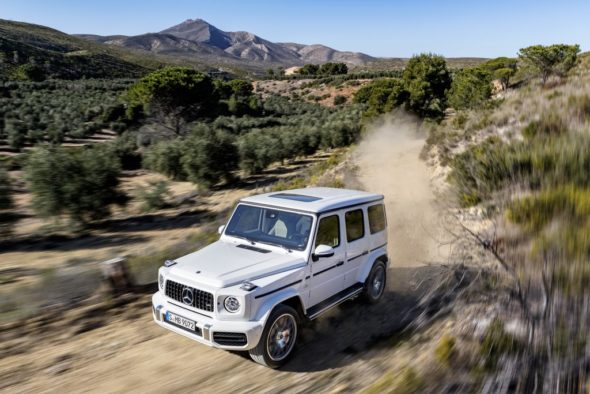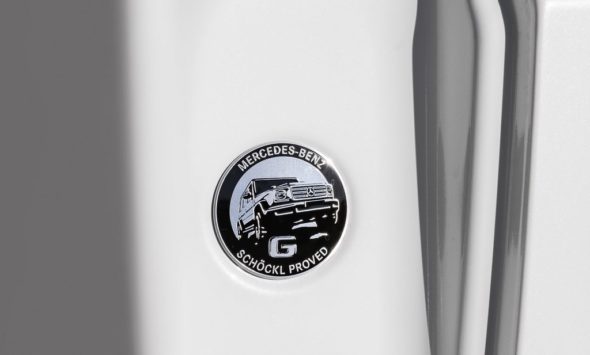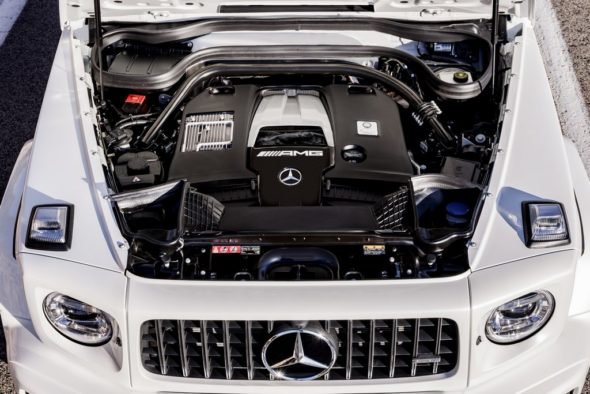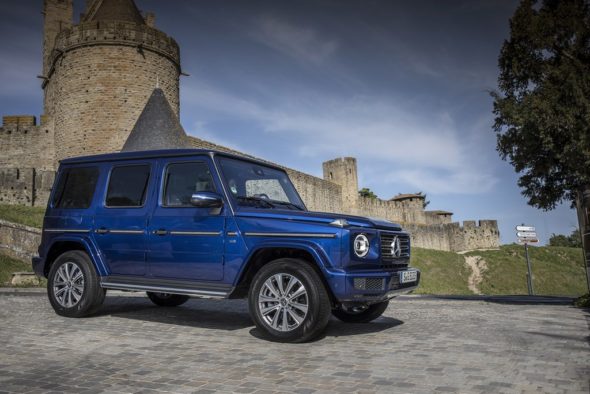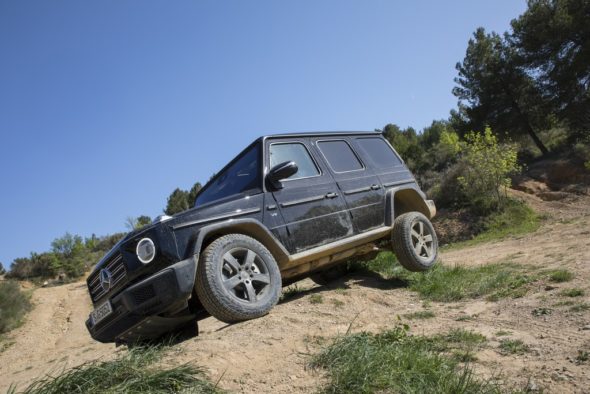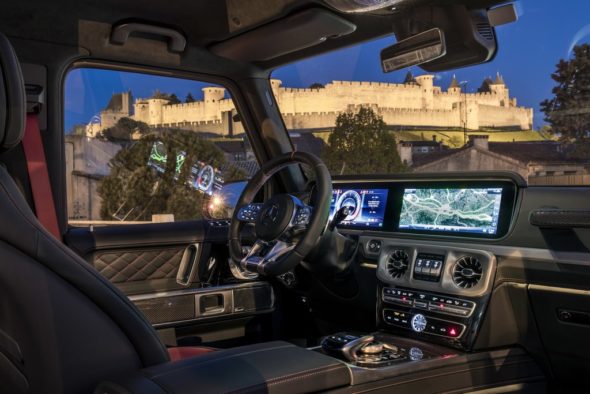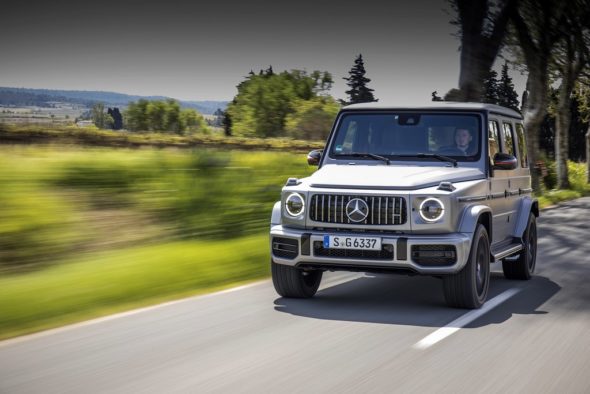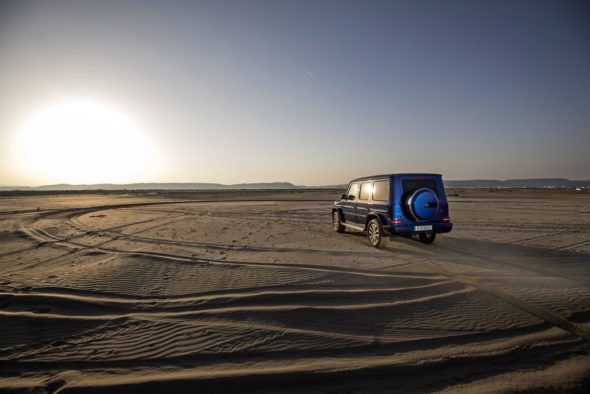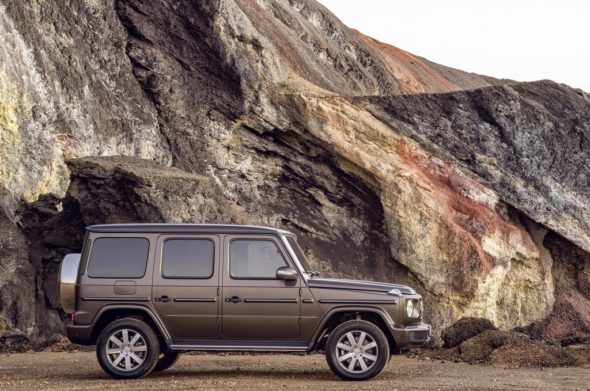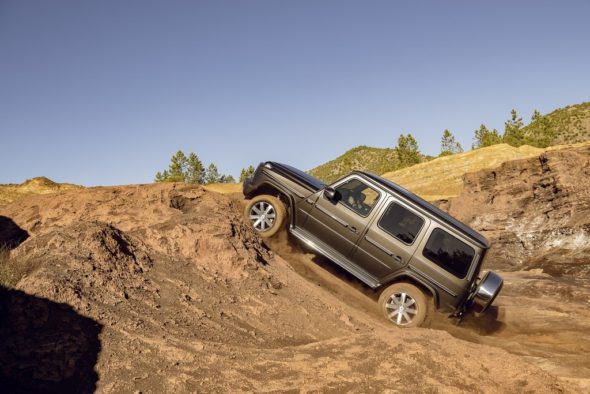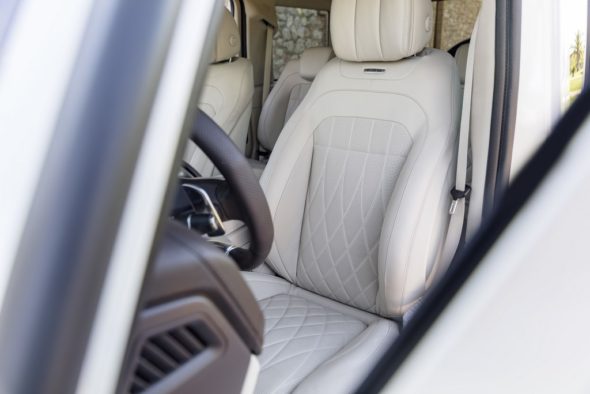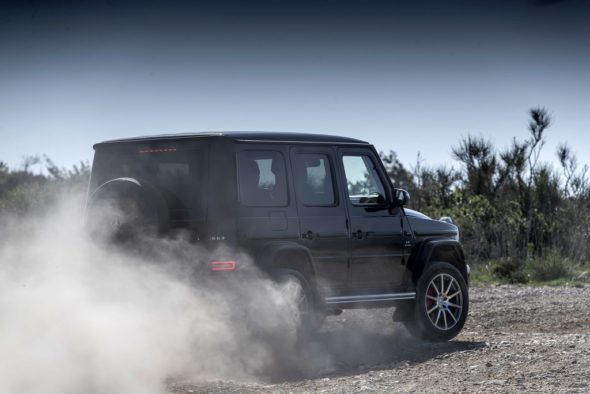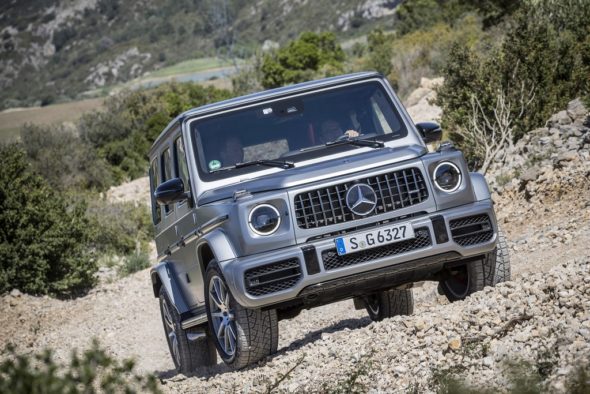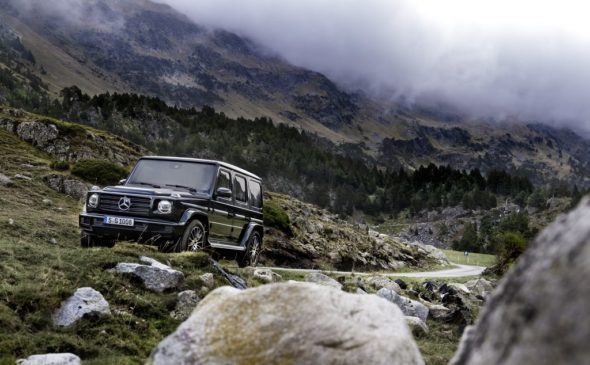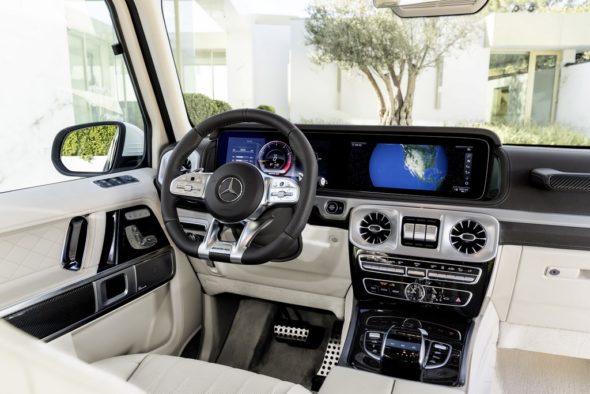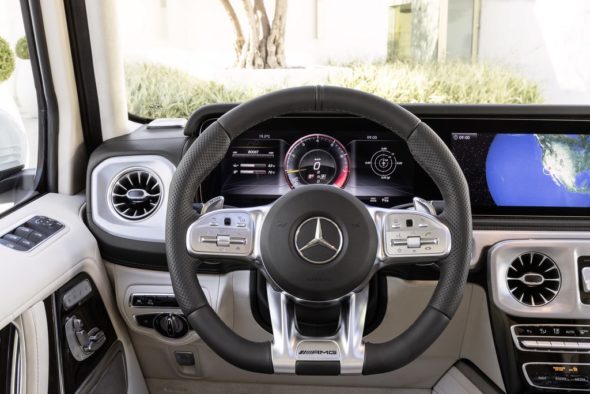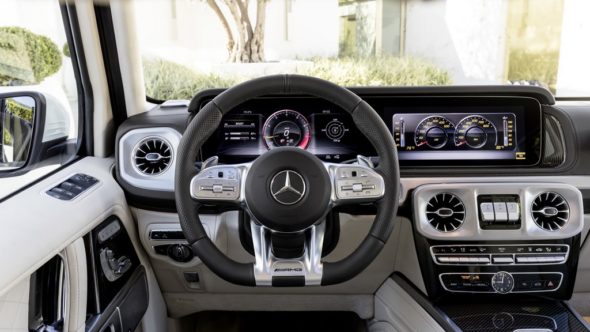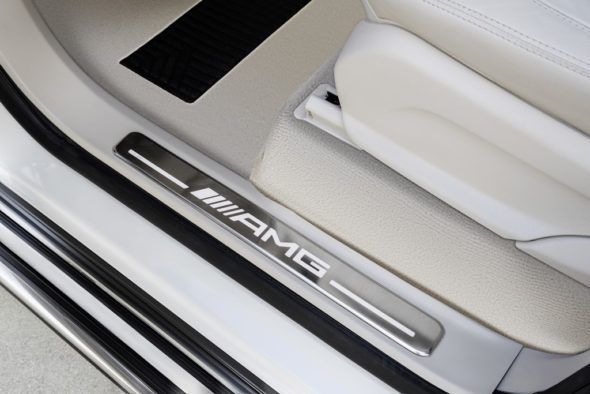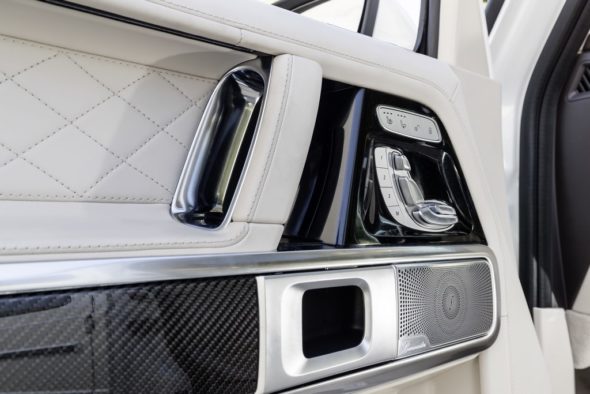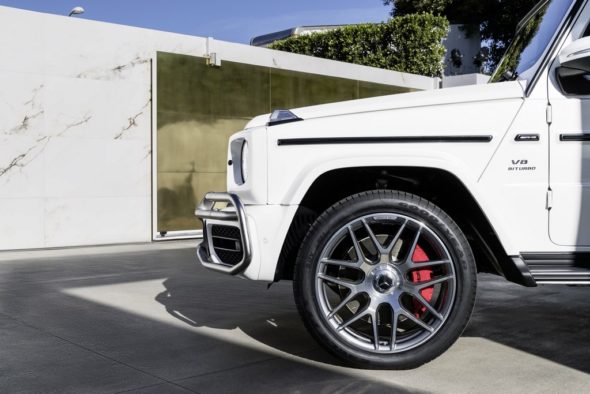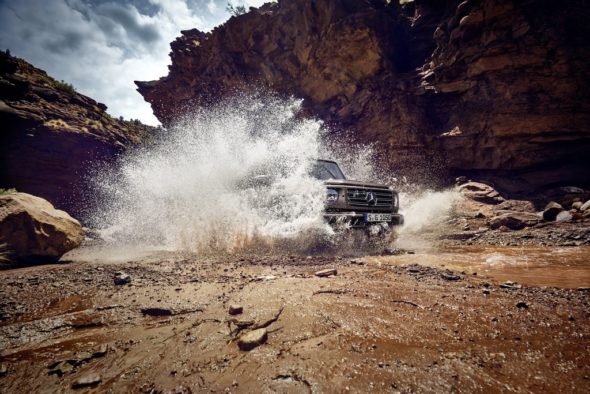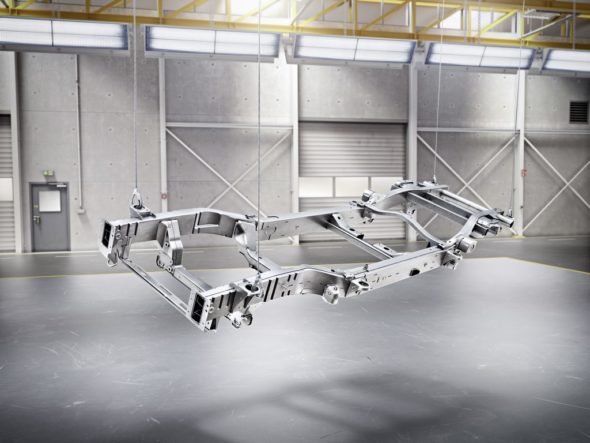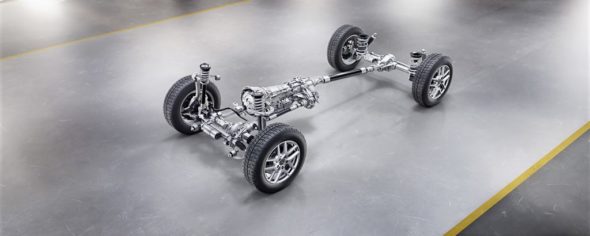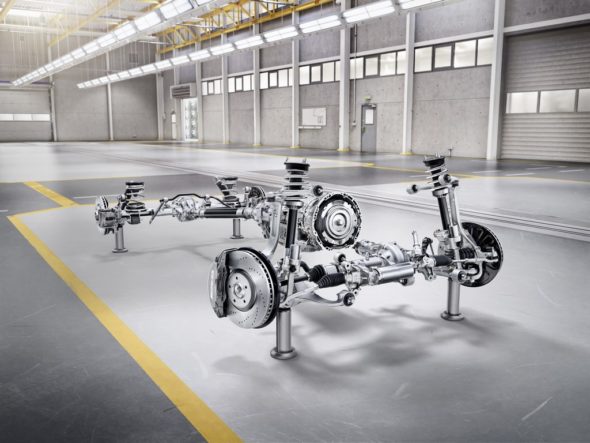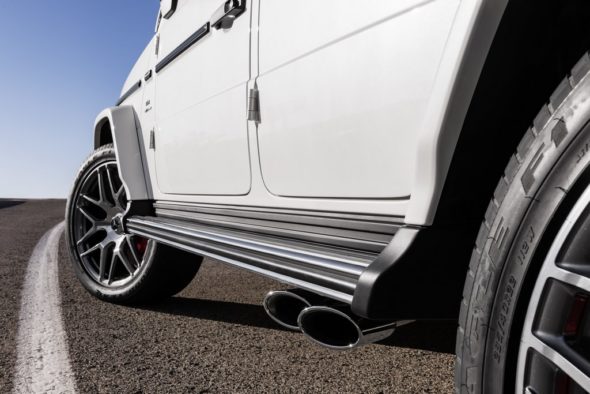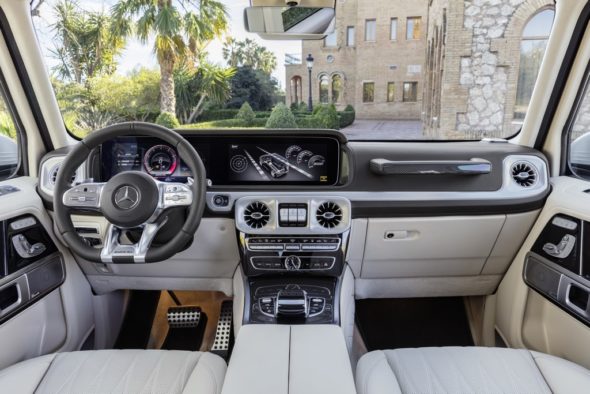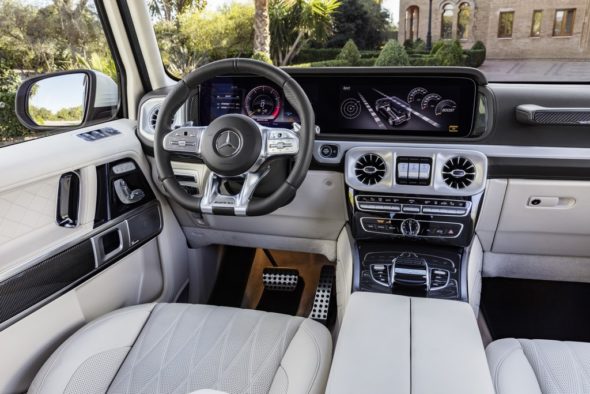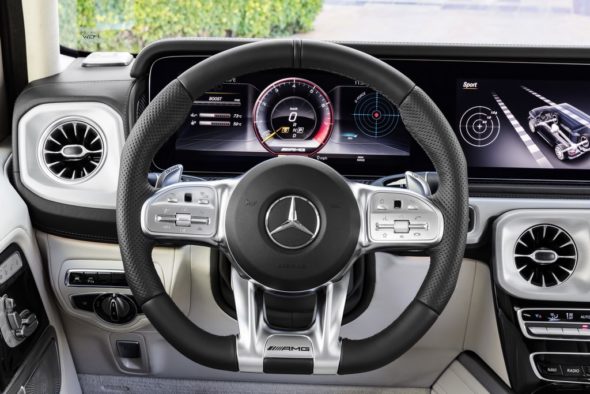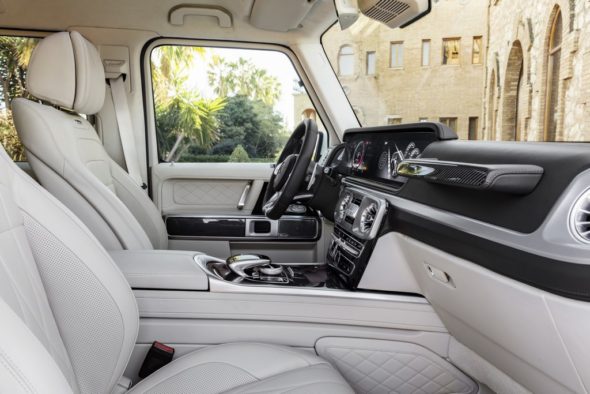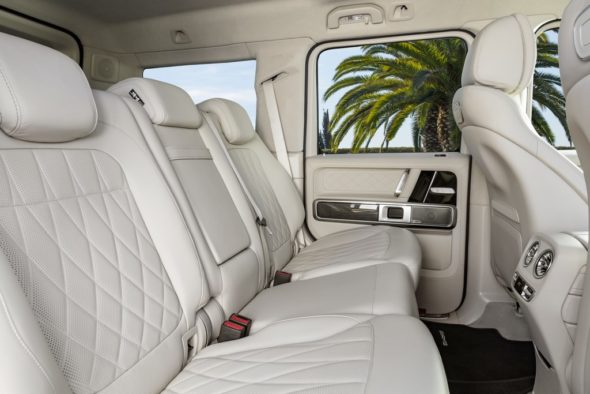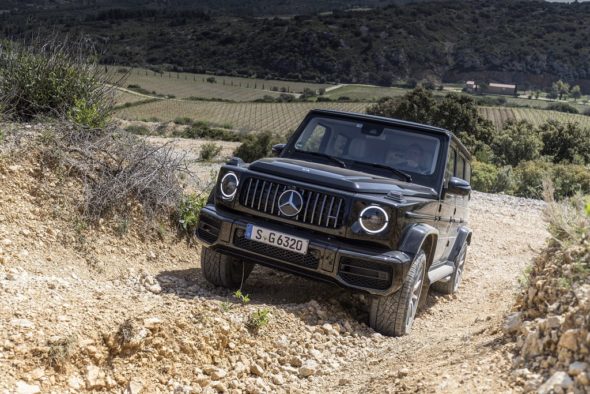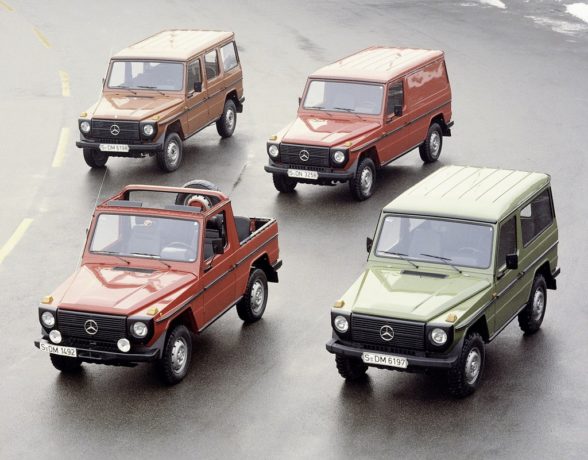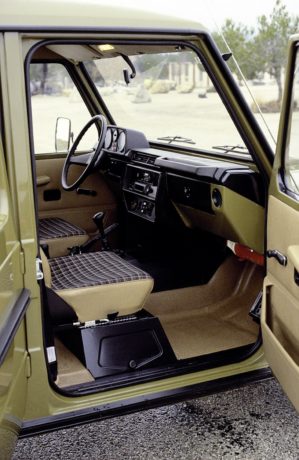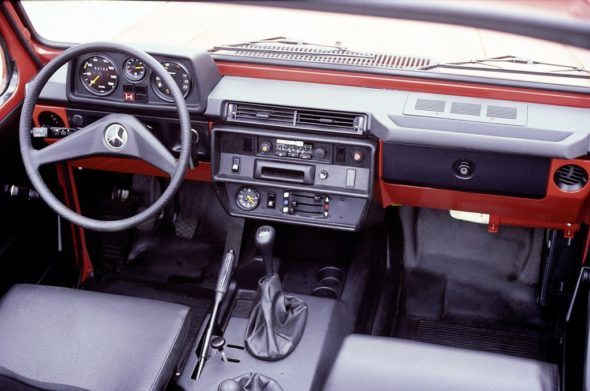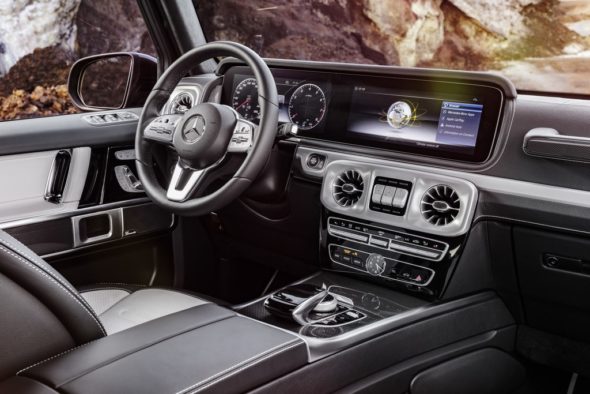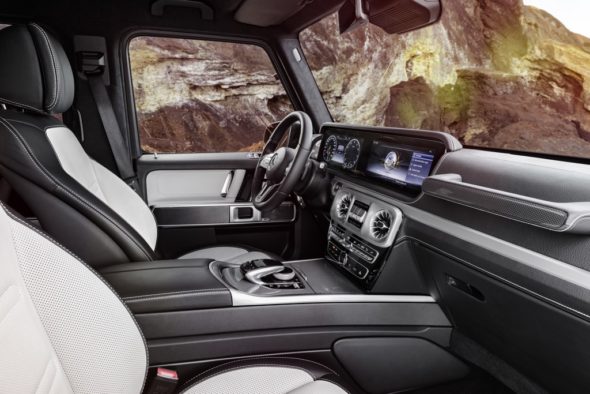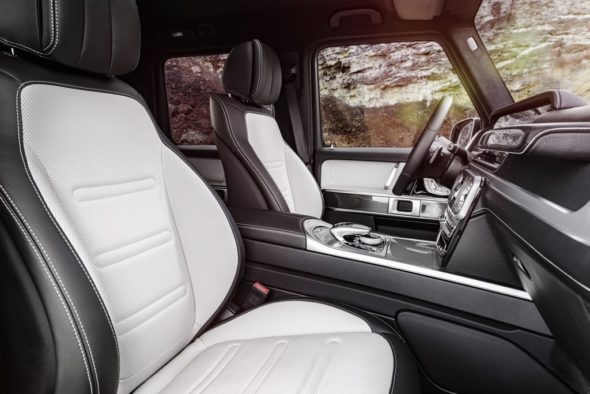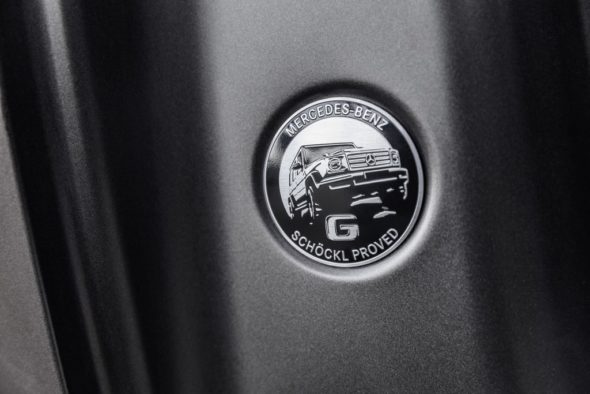The new Mercedes-Benz G-Class
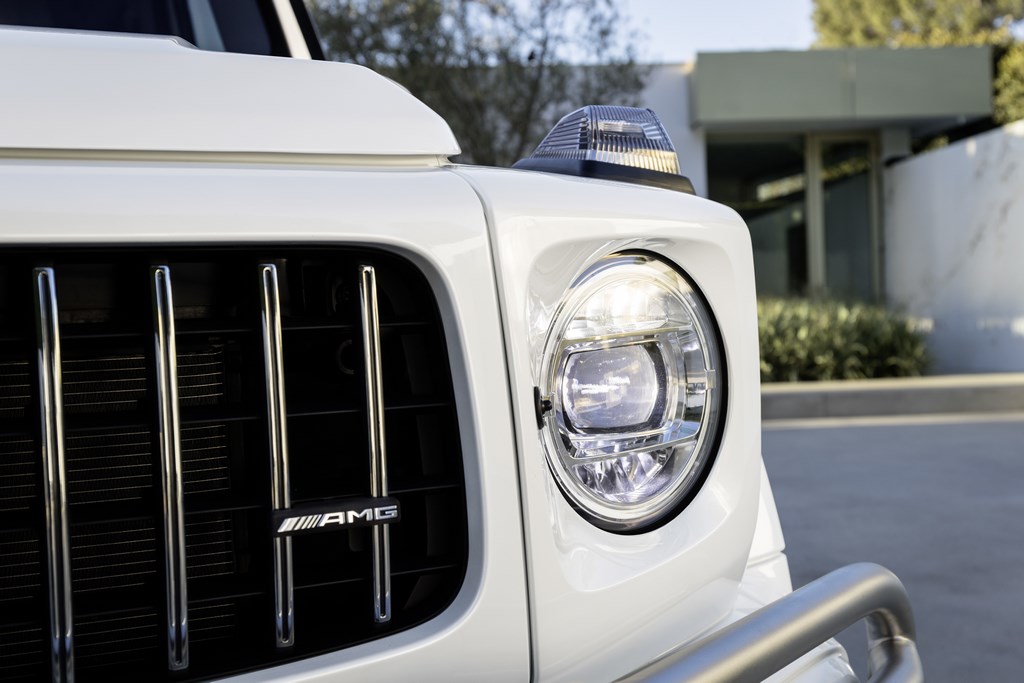
An icon reinvents itself
The new Mercedes-Benz G-Class presents itself in top form. Whether on or off the road and whatever the operating conditions, the off-road vehicle impresses with its performance, cutting-edge assistance systems, outstanding handling, and safety.
At the same time, the new suspension, the DYNAMIC SELECT driving modes, the “GMode” and the three 100percent differential locks enhance not only ride comfort but also agility – on any surface.
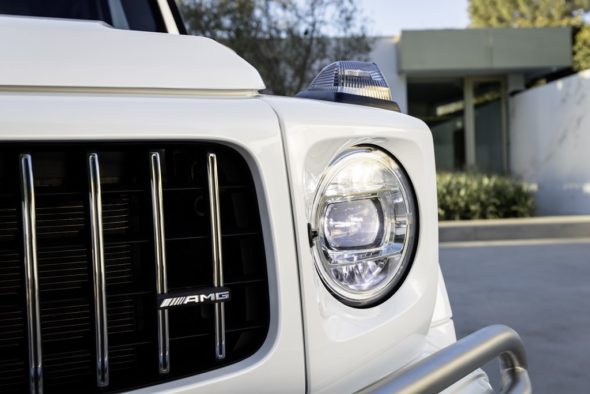
“The new G-Class is setting the bar higher still in all relevant areas – in terms of performance both on and off the road as well as with regard to comfort and telematics. Our ‘longest-serving’ model series is therefore ideally equipped to continue its success story. In short, the new ‘G’ is still a ‘G’, only better,” stresses Ola Källenius, Member of the Board of Daimler AG responsible for Group Research and Mercedes-Benz Cars Development.

Working on the development of the new GClass was extremely challenging for the team. “Further technical development of an icon such as the G-Class was both a challenge and an opportunity at the same time. Each part and every bolt came under close scrutiny,” explains Dr Gunnar Güthenke, Head of the OffRoad Product Group at Mercedes-Benz. “With the body, our main focus was on increasing the vehicle rigidity and the connections between the suspension and drivetrain with the ladder-type frame.”
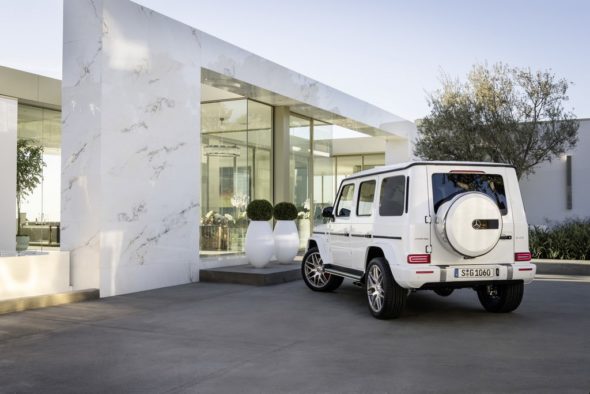
At the time of market launch in June, the GClass will be available at an entry-level price of €107,040.50 (price in Germany, incl. VAT) and thus remains at the level of the preceding version. The specification includes a host of new features such as the LED headlamps, the driving assistance systems, the high-quality interior with leather seats, and the new suspension. For demanding customers, options such as the Exclusive Interior Plus with leather on the interior door panels provides even more exclusivity.
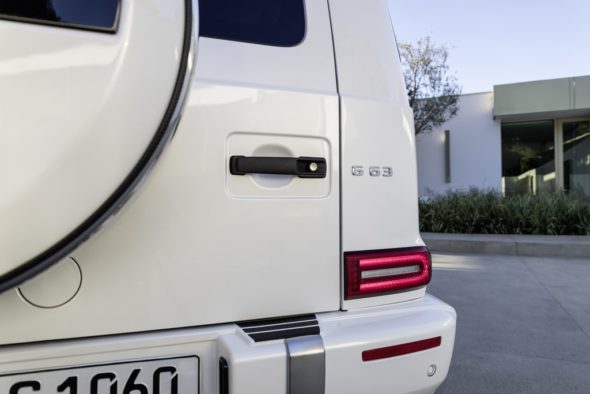
The G-Class, reinterpreted for today
The G-Class, the luxury off-road vehicle from Mercedes-Benz, has long been considered a design icon. Its external appearance has not changed significantly since 1979. Iconic elements continue to serve very specific purposes, now as then, and to give the G-Class its unique appearance. All these are still found in the new G-Class: the distinctive door handle and the characteristic closing sound, the robust exterior protective strip, the exposed spare wheel on the rear door and the prominent indicator lights. Extraordinary features like these in concert with the off-roader’s angular lines define its special look.
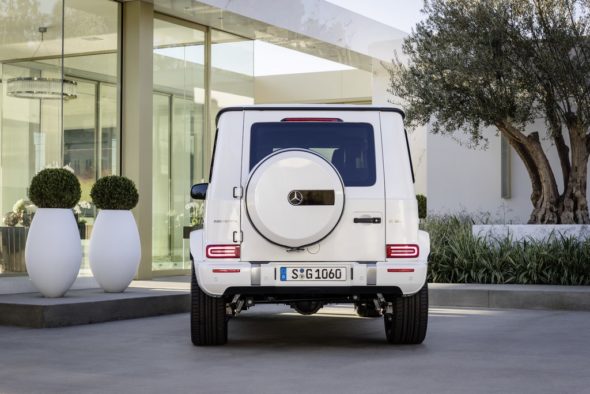
The enhanced design of the G-Class follows the philosophy of Sensual Purity and at the same time remains true to the character of the original. As a result, the door hinges positioned on the outside and the surface-mounted bonnet are carried over to the new generation. With the latest update, the off-road icon – which has been continually enhanced technically over the decades but visually has hardly changed – is making the leap into a new era – both in terms of technology and form. The new G-Class is 53 mm longer and 64 mm wider, and now has even greater presence both on and off the road.
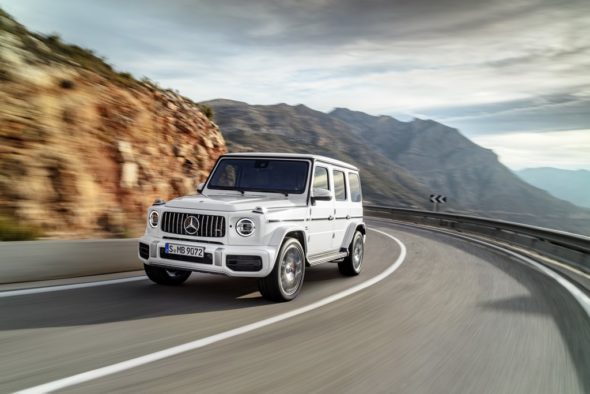
More than ever, the new G-Class appears to be cast from a single piece. All surfaces have a more taut design and are have more tension, while the surface quality has been taken to an even higher level. This results in narrower, more precise gaps and more harmonious transitions. In addition, the wheel arches and bumpers form a more integral part of the body and thus look less like addon features.
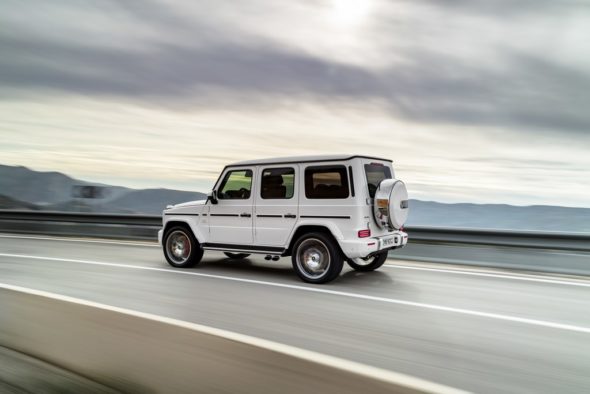
Interior: authentic icon
While the exterior maintains the iconic classic look, the interior of the G-Class has undergone a fundamental modern redesign which reinterprets the genes of the classic vehicle to reflect the exterior. With its off-road character and top-class luxury appointments, the G-Class has always combined two extremes into a harmonious symbiosis. Unmistakable at first glance and from the first touch, only high-quality materials are used. Every detail is finished by hand with the utmost care.
Getting into the G-Class reveals that numerous design features from the exterior have been transposed into the interior. The shape of the round headlamps, for instance, which is reflected in the side air vents. Or the design of the iconic indicators, found again in the shape of the loudspeakers. Hallmarks of the G-Class include the grab handle in front of the front passenger and the chrome-highlighted switches for the three differential locks. Both have been further improved and retained as characteristic features.
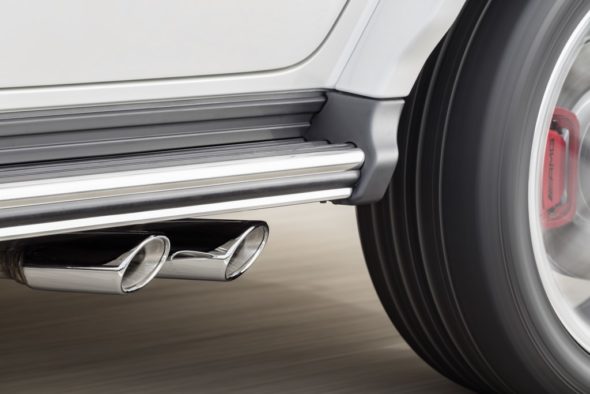
The very clearly arranged and completely redesigned instrument panel features timeless tube-look analogue round dials as standard. In other words, fans of classic round instruments will certainly not be disappointed in the new G-Class. As in the new E-Class and S-Class, an instrument cluster in the form of a large display showing virtual instruments in the driver’s direct field of vision and a central display above the centre console is available as an option. In this case the two 12.3-inch displays blend visually into a Widescreen Cockpit beneath a shared glass cover. Drivers can choose between three different styles for the displays – “Classic”, “Sporty” and “Progressive” – and also select relevant information and views according to their individual needs.
Thanks to haptic impulses and audible feedback from the on-board speakers, drivers can use the touchpad with controller in the centre console without taking their eyes off the road. The input options are rounded off by shortcut keys in front of the controller for frequently used operating tasks, and by the optional control panel for the driving assistance systems above the rotary light switch. The driver sits up close to the windscreen and enjoys good all-round visibility from behind the wheel.

More space for all
The revised dimensions of the now larger G-Class benefit not only the driver and front passenger, but also the passengers in the second row.

The rear seats can be folded down to 60, 40 or 100 percent. The seats in the G-Class are equipped as standard with numerous convenience functions and are ergonomically designed, thus providing enhanced seating comfort and lateral support. Features include the Memory function for the driver’s seat, seat heating front and rear, as well as luxury head restraints in the front. This ride comfort can optionally be boosted still further with the Active Multicontour Seat package.
In addition to the special multicontour seats, this encompasses such features as various massage functions, climate-controlled seats, and fast seat heating. This variant also offers electrically adjustable lumbar support for the driver and front passenger. The side sections of the seat cushions and backrests of the active multicontour seats include integrated air chambers that fill or empty continuously depending on the driving dynamics, thus providing better support for the seating positions of driver and front passenger and, for example, offering more lateral support during cornering. The front seats of the Active Multicontour Seat Package are recommended by experts from the German spinal health organisation “Aktion Gesunder Rücken e.V.”.
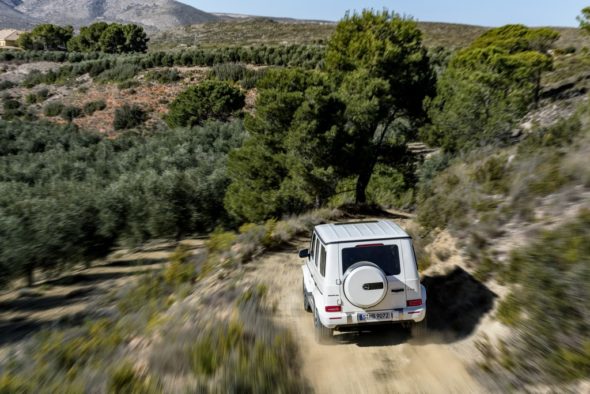
Off-road: the legend surpasses itself
The primary goal of development was to redefine the quality of the handling both on and off the road. This goal has been achieved: the new G-Class performs even better off-road, while on the road it is significantly more agile, dynamic and comfortable than its predecessor. The G thus remains a true G – thanks to its standard ladder-type frame, the three 100-percent differential locks and LOW RANGE off-road gear reduction.

The new suspension is a result of cooperation between Mercedes-Benz G GmbH and Mercedes-AMG GmbH. The result is an independent suspension with double-wishbone front axle in combination with a rigid rear axle. As part of their work, the engineers had the task of fighting for every millimetre, because off-road capability not least also means maximum ground clearance. The raising of the axles makes a decisive contribution in this respect, while requiring a strut tower brace in the engine compartment to achieve the ruggedness objectives.
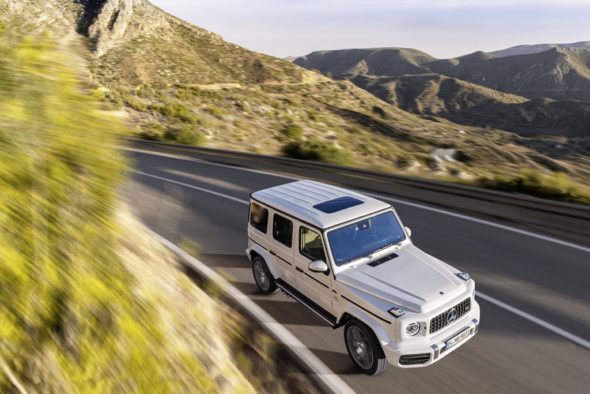
The components of the double-wishbone front suspension are directly mounted to the ladder-type frame without a subframe. The lower wishbone’s attachment points on the frame in Z-direction are positioned as high up as possible. This arrangement ensures good driveability beyond the asphalt. Specifically for the G-Class, the new front axle is designed in such a robust way that the off-road performance and off-road capabilities of its predecessor are maintained and partly even surpassed.
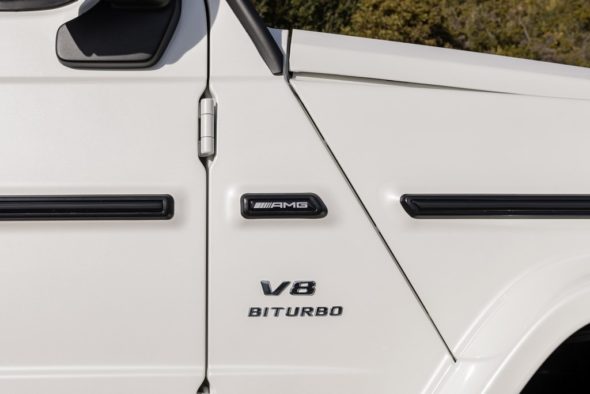
Equipped in this way and with a ground clearance of 270 mm to the front axle gear, the G-Class provides plenty of potential for maximum assertiveness and driving pleasure in off-road terrain.
The figures speak for themselves:
Slope climbing ability of up to 100% on suitable surfaces
Ground clearance between axles, plus 6 mm, now 24.1 cm
Maximum fording depth now 70 cm when driving through water and mud, no less than an additional 10 cm
Stable at tilt angles of 35°, plus 7°
Angle of departure: 30°, angle of approach: 31°, plus 1°
Break-over angle: 26°, plus 1°

Thanks to the independent suspension, it was possible to improve the rigidity of the body front end. A strut tower brace, known as a suspension bridge, now connects the front strut towers, which increases the torsional rigidity of the ladder-type frame.
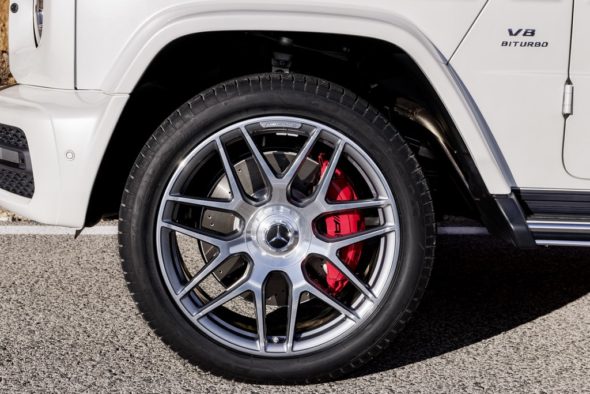
At the rear, in contrast to the predecessor, the new rigid axle is controlled by four trailing arms on each side and a Panhard rod. This makes normal driving on the road even more comfortable. In off-road terrain, the rear spring jounce of 82 mm and rebound of 142 mm plus the ground clearance of 241 mm to the rear axle gear help to ensure a safe ride even in extreme situations.

À la carte: “Comfort”, “Sport”, “Individual” or “Eco”
DYNAMIC SELECT is now available with several driving modes for the G-Class. This allows adjusting the vehicle characteristics in seconds at the touch of a button, as the system modifies the characteristics of the engine, transmission, suspension, steering and assistance systems at the driver’s behest.
The driving modes “Comfort”, “Sport”, “Eco” and “Individual” can be set conveniently via the DYNAMIC SELECT rocker switch. In “ECO” mode, a particularly fuel-optimised driving style is possible, for example. In “Sport” mode, on the other hand, the shift points of the automatic transmission, the throttle response of the engine, and the parameters of the electric steering system and the exhaust flap are changed. “Individual” allows drivers to configure their own preferred vehicle settings.
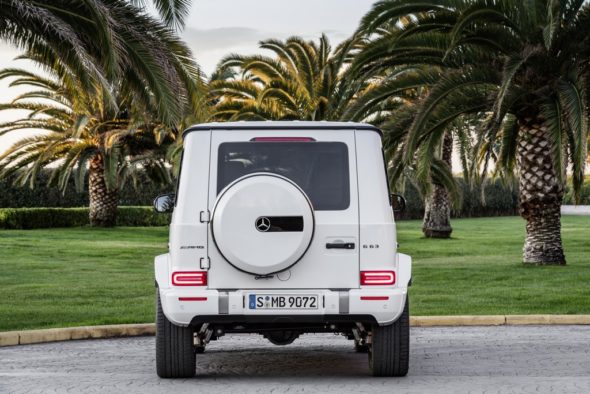
DYNAMIC SELECT provides a host of options in combination with the new suspension with optional Adaptive Damping System. The driver is then also able to modify the vehicle’s damping characteristics in Sport and Comfort modes using the DYNAMIC SELECT switch.
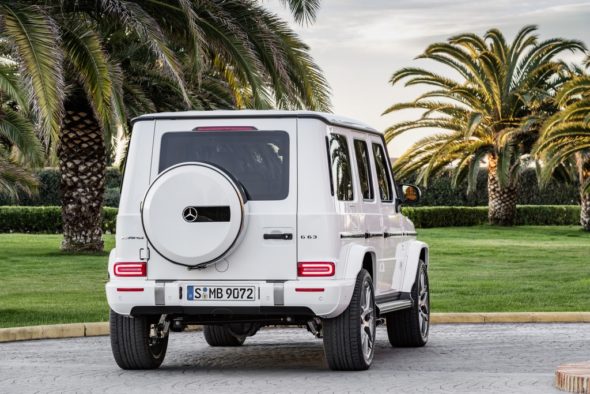
Put simply, the G-Class detects the particular condition of the road and sets the appropriate damping characteristics, so that the damping in off-road terrain is stiffer, for example. In contrast, in Sport mode the G-Class boasts a more agile response when driving on the road.
The new “G-Mode” paves the way where there is none
One of the prerequisites for the improved off-road handling characteristics is the new “G-Mode”. The G-Class changes to “G-Mode” independently of the chosen driving mode as soon as one of the three differential locks has been activated or the LOW RANGE off-road reduction gear has been engaged.
This off-road mode adapts the adjustable damping of the chassis and the steering as well as the accelerator characteristic, avoids unnecessary gear shifts and thus ensures optimum control and maximum off-road capability. A small “G” icon discreetly lights up in the instrument cluster. The “G” swallows rough ground so easily that the driver is able to enjoy inch-perfect manoeuvring even in the steepest terrain, and receive excellent steering feedback on the traction provided by the surface.
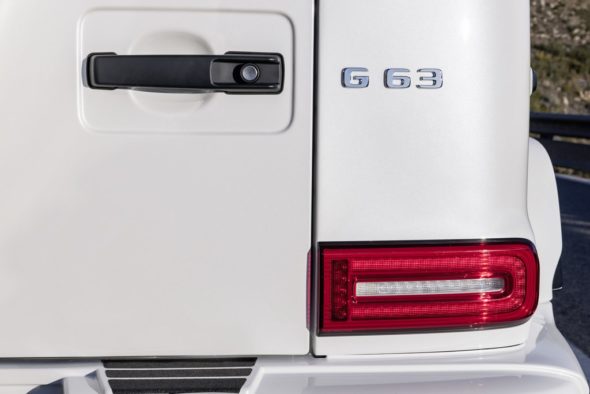
On-road: agile, comfortable, superior
The specification for the G-Class not only included solidness and superiority in off-road terrain, but also greater driving dynamics and comfort on paved roads. Thanks to the new front axle design, the on-road performance of the G-Class has therefore been enhanced at the same time.
On the road, the “G” is as agile as it is comfortable and provides the driver with a better steering feel. The off-roader stays on track more solidly, and is agile and effortless when driving off-road.
Using a digital prototype, the developers simulated the service life of individual components and closed systems to find out in which places it would be possible to make use of lighter raw materials. The diet worked, as the G-Class has shed around 170 kg. The recipe for success: a new mix of materials comprising strong, high-strength, ultra-high-strength steels and aluminium, as well as improved production processes at the Magna Steyr plant in Austria. The rigid bodyshell is now made of a variety of steel grades, while the wings, bonnet and doors are made of aluminium.
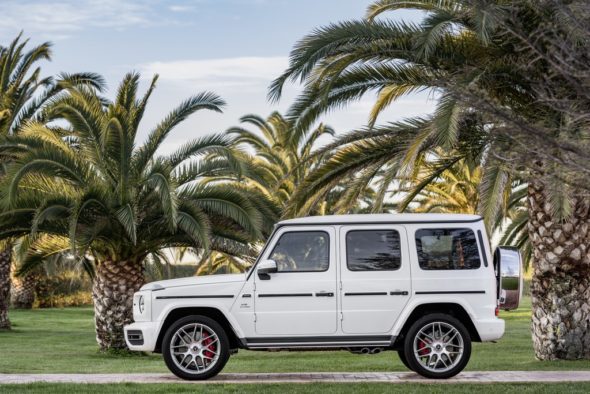
To be able to retain the door hinges and handles typical of the G-Class, the developers modified these to suit the new aluminium design. The A and B-pillars are made of high-strength steel in view of their load-bearing function. However, less mass in no way translates into less stability – on the contrary, it was possible to increase the torsional rigidity of the frame, bodyshell and body mounts by around 55 percent, from 6537 to 10,162 Nm/deg.
Alongside improvements to the natural driving dynamics and comfort, this also results in enhanced quality in terms of noise levels, among other things, with the positive effect of significantly less noise and vibrations being noticeable in the interior when driving.

Powerful and efficient
In the new G 500 (fuel consumption, combined: 12.1-11.5 l/100 km; combined CO2 emissions: 276-263 g/km)1 a high-performance 4.0-litre V8 petrol engine ensures powerful propulsion. The new biturbo produces an output of 310 kW (422 hp) and a maximum torque of 610 Nm at 2000 to 4750 rpm.
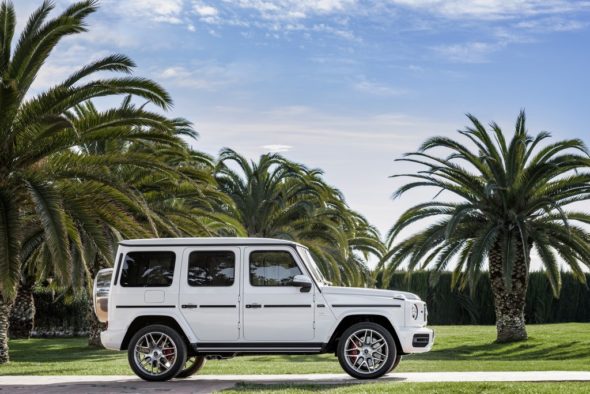
New automatic transmission on board
For the transfer of power, the 9GTRONIC automatic transmission with torque converter was specifically adapted to meet the needs of the off-road icon. The developers have managed to reduce the shift and response times of the 9-speed transmission by means of a dedicated software application. The wide transmission ratio not only makes driving quieter and more comfortable especially at low engine speeds, it simultaneously also contributes to reducing fuel consumption.

As direct as possible, as indirect as necessary
As standard the G-Class is now fitted with electromechanical rack-and-pinion steering, which now allows driving assistance systems such as Parking Assist to be implemented. In addition, the electromechanical steering uses less energy than a hydraulically assisted steering system.
Depending on the driving mode, one of three sets of steering characteristic lines, namely Comfort, Sport and Off-road, comes into effect. This ensures a comfortable or sporty steering feel on the road, but also straightforward and precise feedback in unpaved and demanding terrain – always paired with sufficient steering power assistance. In a nutshell: as direct as possible, as indirect as necessary.
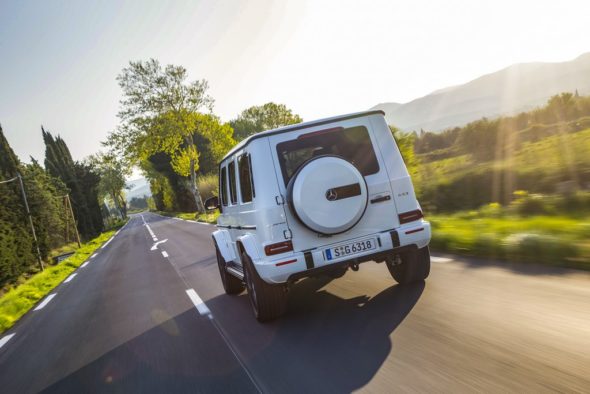
Stronger than time
The G-Class is the top model among luxury off-road vehicles. It is not only the passenger car model series with by far the longest production run in the history of Mercedes-Benz, but also the forefather of all SUVs bearing the three-pointed star – this is why all Mercedes off-road models feature the upper-case G in their name.

What began in 1972 with a collaboration agreement between then Daimler-Benz AG and Steyr-Daimler-Puch in the Austrian city of Graz is now a story peppered with superlatives and significant milestones. The first concept to be developed was already different. The team designed a vehicle which impressed with superior off-road capability, while at the same time appealing to customers as a full-featured and safe vehicle suitable for recreational purposes. All-wheel drive and 100-percent differential locks have also been part of the “G” since that time, as has the robust ladder-type frame.

At the time of its market launch, in the spring of 1979, it was available with a choice of four engine variants covering a performance range from of 53 kW/72 hp to 115 kW/156 hp. Customers had the option of a Cabriolet with a short wheelbase or Station Wagon models with short or long wheelbase. In 1989 the vehicles of the model series 463 marked the beginning of an evolutionary process for the off-roader that was not just about keeping pace with technical progress. It was an evolution that also brought a steadily expanding fan base and emphasised its character as an exclusive vehicle for any occasion. And, since 1993, a vehicle with an official name: the G-Class.

The G-Class models used for the “Popemobile” are famous around the world. The off-road Mercedes-Benz 230 G painted in mother of pearl with a transparent special body accompanied Pope John Paul II on numerous journeys from 1980.
The 25th anniversary of the G-Class was marked by the arrival of a very special model on the market, honed by Mercedes-AMG: the G 55 AMG Kompressor. Its eight-cylinder power unit (350 kW/476 hp, 700 Nm of torque) gave the robust off-roader an unprecedented level of performance and demonstrated the tremendous potential of the G-Class.

The G 500 4×4² of 2015 added not only a luxurious interior to the equation, but also a ground clearance of 45 centimetres and impressive on-road performance. Since 2015, the designo custom shop has been providing customers with the option to take a G-Class and make it their own individual “G” – with exclusive equipment variants that are perfectly coordinated with each other.
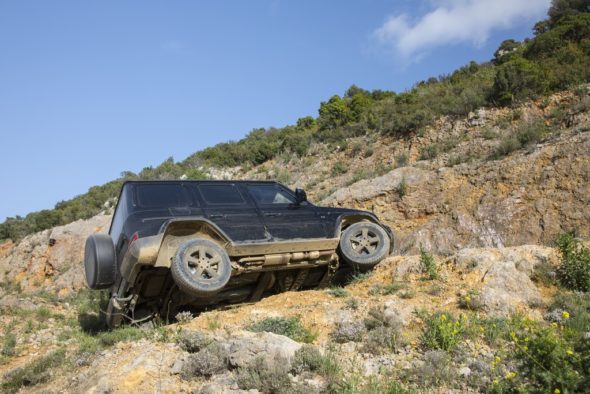
Thanks to the Mercedes-Maybach G 650 Landaulet, the iconic G-Class reinvented itself once more in 2017. With its superlative V12 engine, portal axles, electric fabric top and exclusive appointments in the rear compartment, this very special all-terrain vehicle, limited to 99 units, meets the expectations of customers who demand the very highest standards of their vehicle. Arguably the most exclusive form of open-air driving pleasure.
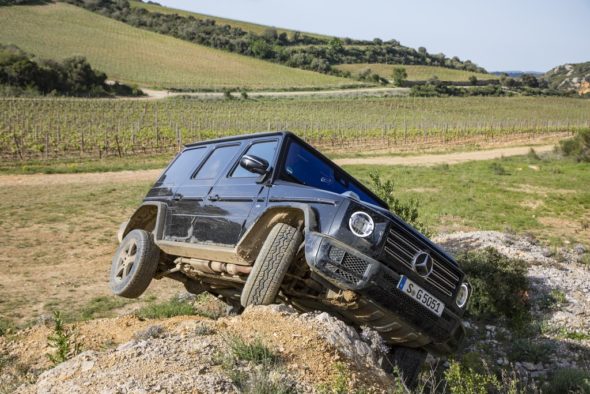
The summer of 2017 saw the 300,000th G-Class roll off the assembly line in Graz – a Mercedes-Benz G 500 in designo Mauritius blue metallic with black leather seats and contrasting white topstitching. Equipped with a range of off-road features including all-terrain tyres mounted on black 16-inch rims and a sturdy roof rack, the anniversary vehicle embarked on new adventures over the summer.
G-Class fans around the world determined the vehicle specification by voting for their favourite equipment and appointments on the official G-Class Facebook page. The future road trips of the 300,000th G-Class can be followed on social networks.
1 The stated figures were determined in accordance with the prescribed measuring method. These are the “NEDC CO2 figures” according to Art. 2 No. 1 Implementing Regulation (EU) 2017/1153. The fuel consumption figures were calculated based on these figures.

Design
An unmistakable character
The G-Class, the luxury off-road vehicle from Mercedes-Benz, has long been considered a design icon. Its external appearance has not changed significantly since 1979. Its unmistakable shape is its trademark, and together with its extraordinary off-road attributes this has made it the trendsetter in the off-road segment.
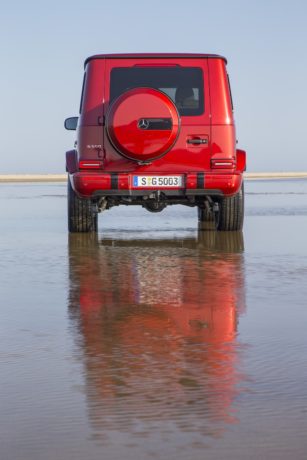
The aim behind the new G-Class is to make the elegance and high quality of the vehicle even more obvious, for an even more striking appearance. “The new G-Class is setting the bar higher still in all relevant areas – in terms of performance both on and off the road as well as with regard to comfort and telematics. Our ‘longest-serving’ model series is therefore ideally equipped to continue its success story. In short, the new ‘G’ is still a ‘G’, only better,” stresses Ola Källenius, Member of the Board of Daimler AG responsible for Group Research and Mercedes-Benz Cars Development.

The further evolved design of the G-Class follows the philosophy of Sensual Purity and at the same time remains true to the character of the original. The design once again confirms that this Mercedes-Benz off-roader is an icon, and that no other has the same, up-to-date on-road capabilities together with superior off-road capabilities. It is both hot and cool at the same time.

“The G-Class is the measure of all SUVs. We have given due deference to the character of this icon, and yet exercised puristic reduction to create the transition to modern luxury,” says Gorden Wagener, Chief Design Officer Daimler AG. The distinctive door handles and the characteristic closing sound, the robust exterior protective strip, the exposed spare wheel on the rear door and the prominent indicator lights remain typical features.
Other typical G-Class features include the plain, rectangular tail lights, which are now contoured and mounted to the body.
The door hinges positioned on the outside and the surface-mounted bonnet are also carried over to the new generation. With the latest update, the off-road icon – which has been continually enhanced technically over the decades but visually has hardly changed – is making the leap into a new era – both in terms of technology and form. The new G-Class is 53 mm longer and 64 mm wider, and now has even greater presence, both on and off the road.
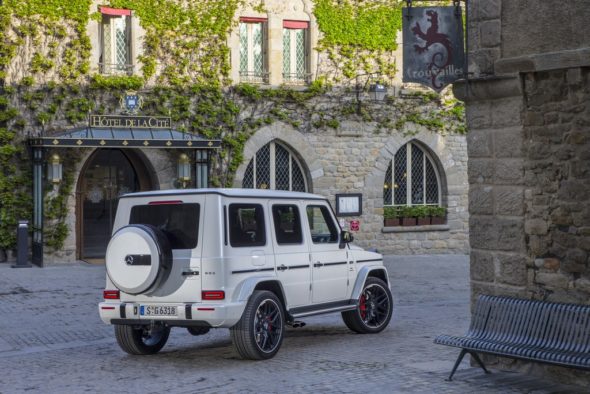
Tauter surfaces, precise transitions, intelligently conceived details
More than ever, the new G-Class appears to be cast from a single piece. All surfaces have a more taut design and are have more tension, while the surface quality has been taken to an even higher level. This results in narrower, more precise gaps and more harmonious transitions. In addition, the wheel arches and bumpers form a more integral part of the body and thus look less like addon features.
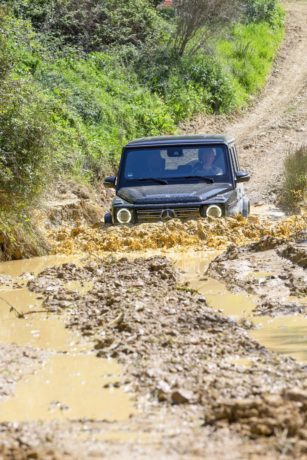
Off-road capabilities were already incorporated into the design during the development of the first G-Class. A principle that has proved successful to this day. The chamfered sides of the square headlamps help to ensure that the body and headlamps are less susceptible to damage when driving on rough terrain or through narrow stretches, for example. All lighting functions including the daytime running lamps are integrated into single headlamp units. Customers have a choice between LED headlamps and high-resolution MULTIBEAM LED headlamps.

Distinctive grille meets an iconic spare wheel
The front section is characterised by the striking radiator grille in a three-louvre design with painted inlays and a large, central Mercedes star, steep A-pillars and a flat windscreen. The louvre carriers and inlays are individually styled depending on the equipment line, and e.g. painted in obsidian black. As optional equipment the inlays are available in high-gloss chrome. In this case the louvre carrier is in matt iridium silver.

Clear lines and large surfaces characterise the side view. The classic, short overhangs emphasise the balanced proportions of the off-roader. The side skirts, beltline and drainage strip take a parallel course. The side rub strip, which is semi-integrated like the tail lights, is just as functional and horizontal at the height of the door handles. On request this is available with pinstripes or in a striated or brushed aluminium look. Depending on the choice of optional equipment, running boards make access and egress easier.
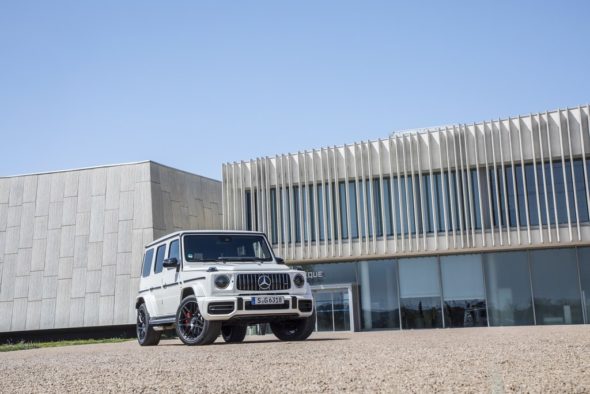
Thanks to its wide track, a slightly trapezoidal rear window and prominent wheel arch linings, the G-Class appears very four-square when viewed from the rear. The rear fog lamp is integrated into the LED tail light. A large door hinged on the left carries the spare wheel and gives access to the luggage or cargo area. As a distinctive feature, the designers retained the external hinges on the rear door and all other doors.
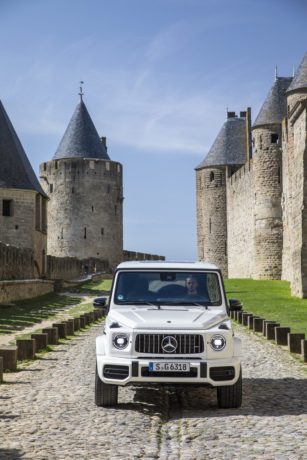
The reversing camera is now positioned below the spare wheel, so that the driver has a clear view to the rear and can manoeuvre with millimetric precision. Unusual detail: for maximum reliability, the camera is waterproofed and therefore also protected against soiling; owing to the 100-millimetre increase in the fording depth of the new G-Class to 700 mm, it may be below the waterline in extreme cases.
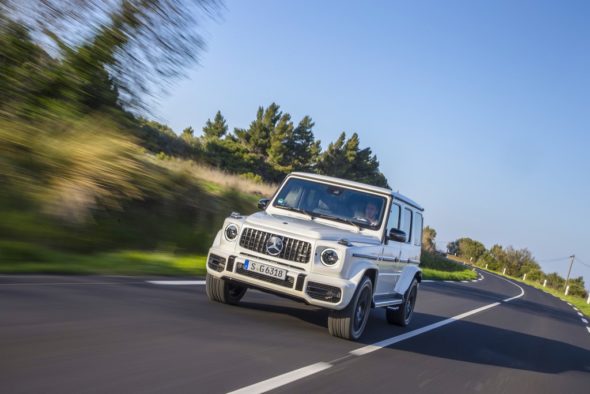
The new, optional electric glass sliding roof not only gives pleasant ventilation to the interior, but also a view to the outside thanks to tinted glass. And should it start to rain, the roof automatically moves to the tilted position. In the event of an accident, the PRE-SAFE® system closes the glass roof if a rollover threatens.

Customers have a choice of eleven new exterior paint finishes, e.g. brilliant blue or designo mystic white bright. 24 paint colours are available, of which nine are metallic and 13 are designo manufaktur colours.

Interior: as luxurious as it is authentic
While the exterior maintains the iconic, classic look, the interior of the G-Class has undergone a fundamental modern redesign which reinterprets the genes of the classic vehicle to reflect the exterior. With its off-road character and top-class luxury appointments, the G-Class has always combined two extremes into a harmonious symbiosis.
Unmistakable at first glance and from the first touch, only high-quality materials are used. Every detail is finished by hand with the utmost care. Getting into the G-Class reveals that numerous design features from the exterior have been transposed into the interior. The shape of the round headlamps, for instance, which is reflected in the side air vents. Or the design of the iconic indicators, found again in the shape of the loudspeakers.
The driver, co-driver and passengers in the second row benefit from the increase in width, and therefore the more spacious interior of the off-roader. Hallmarks of the G-Class include the grab handle in front of the front passenger and the chrome-highlighted switches for the three differential locks. Both have been further improved and retained as characteristic features. In an accident the front passenger airbag deploys above the grab handle.

The centre console benefits from the design freedom and has been completely newly configured to meet the functional requirements. The touch-sensitive Touch Controls on the steering wheel respond to swiping motions in the same way as the surface of a smartphone. They enable the driver to control the entire infotainment system without having to take their hands off the steering wheel.
The very clearly arranged and completely redesigned instrument panel features timeless tube-look analogue dials as standard. In other words, fans of classic round instruments will certainly not be disappointed in the new G-Class. As in the new E-Class and S-Class, an instrument cluster in the form of a large display showing virtual instruments in the driver’s direct field of vision and a central display above the centre console is available as an option.
In this case the two 12.3-inch displays blend visually into a Widescreen Cockpit beneath a shared glass cover. Drivers can choose between three different styles for the displays – “Classic”, “Sporty” and “Progressive” – and also select relevant information and views according to their individual needs.
Thanks to haptic impulses and audible feedback from the on-board speakers, drivers can use the touchpad with controller in the centre console without taking their eyes off the road. The input options are rounded off by shortcut keys in front of the controller for frequently used operating tasks, and by the optional control panel for the driving assistance systems above the rotary light switch. The driver sits up close to the windscreen and enjoys good all-round visibility from behind the wheel.
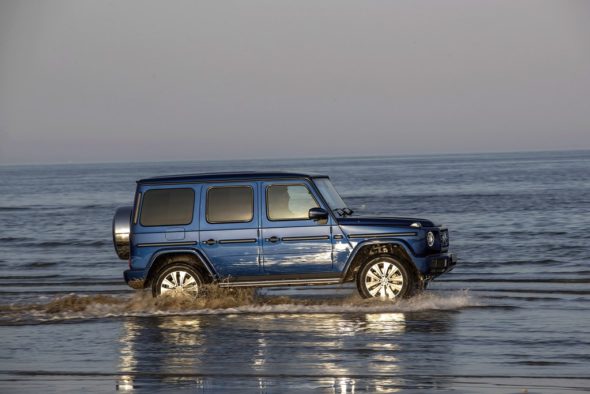
Tasteful: high-quality materials
With its unmistakable character and high-quality appointments, the G-Class has always managed to combine off-road capability and luxury in a particularly harmonious way. Even in its standard specification, the G-Class’s timeless and authentic open-pore wood trim gives it an air of classical elegance. Its stylish details include the generous use of high-quality metal or carbon fibre trim, and its leather seats.
The doors are very solid, clear evidence of that hallmark “G” functionality. A well-conceived stowage space concept with numerous stowage compartments e.g. in the armrest or in the rear doors ensures that everything has its place.
There is now an illuminated compartment under the armrest for items such as a penknife or sunglasses. The adjustable backrest of the rear bench seat is free-standing for maximum variability. Ten adjustment stages from Comfort to Cargo allow maximum flexibility.

Schöckl proved
“Every G-Class must be put to the test on the Schöckl.” And this was the motto that headed the list of requirement specifications when it came to redesigning this classic among off-roaders. The Schöckl is the mountain just outside Graz in the Austrian state of Styria which Mercedes-Benz uses for test drives, and which every off-roader since the early development days of the “G” in the early 1970s has had to overcome. Which is why every “G” bears a certification mark in the form of a “Schöckl” on both sides at the base of its B-pillar.

The driver, co-driver and passengers benefit from the larger dimensions of the new G-Class. Legroom for the rear passengers has increased by 15 centimetres, and by 3.8 centimetres for the driver and co-driver.
Key data at a glance:
Description Difference
Legroom in the front +38 mm
Legroom in the rear +150 mm
Shoulder room in front +38 mm
Shoulder room in rear +27 mm
Elbow room in front +68 mm
Elbow room in rear mm +56 mm
The rear seats can be folded down to 60, 40 or 100 percent. The seats in the G-Class are equipped as standard with numerous convenience functions and are ergonomically designed, thus providing enhanced seating comfort and lateral support. Other features are e.g. the memory function for the front seats, front and rear seat heating and luxury head restraints in the front.
This ride comfort can optionally be boosted still further with the Active Multicontour Seat package. In addition to the special multicontour seats, this encompasses such features as various massage functions, climate-controlled seats, and fast seat heating. This variant also offers electrically adjustable lumbar supports for the driver and front passenger.
The side sections of the seat cushions and backrests of the active multicontour seats include integrated air chambers that fill or empty continuously depending on the driving dynamics, thus providing better support for the seating positions of driver and front passenger and, for example, offering more lateral support during cornering. The front seats of the Active Multicontour Seat Package are recommended by experts from the German spinal health organisation “Aktion Gesunder Rücken e.V.”.

Connectivity and digitisation using the latest technology is provided by the infotainment system COMAND Online included as standard. This begins with effortless integration of a smartphone into the onboard infotainment system. Phone calls can then be conveniently made via the Bluetooth® hands-free system.
Apple’s smartphone-based infotainment system CarPlay® and Google’s Android Auto™ can also be used with COMAND Online. If a corresponding smartphone is connected by USB, the customer can, if desired, switch to the CarPlay® or
Android AutoTM interface.
Modern-style navigation
COMAND Online offers fast 3D hard-drive navigation with topographical map display, 3D buildings and 3D map rotations. The system presents its content interactively and its features include an animated compass. COMAND Online uses the familiar traffic data service Live Traffic Information. This allows reception of up-to-date and precise traffic information in real time for an exact estimate of the time of arrival.
Audio playback is possible from various sources. For example via Bluetooth® or USB stick. COMAND Online also offers video playback and an integrated hotspot functionality for up to three mobile devices. It allows passengers in all seats to connect different WiFi-capable devices, such as laptop or tablet computers, to the internet.

Exquisite listening experience
The standard audio system features seven loudspeakers. The Burmester® surround sound system with 15 speakers and a 590 watt amplifier with Digital Sound Processing is available as optional equipment. The listening experience is particularly remarkable in the low bass range, which has especially good sound resolution.

Mercedes me connect: a direct connection to the vehicle
Under the name “Mercedes me connect”, Mercedes-Benz offers an extensive package of free standard services and Remote Online services via an on-board communication module. The range of services is being expanded continuously. The free basic services include Mercedes-Benz emergency call (eCall), Accident Recovery, Breakdown Management and Remote vehicle diagnostics.
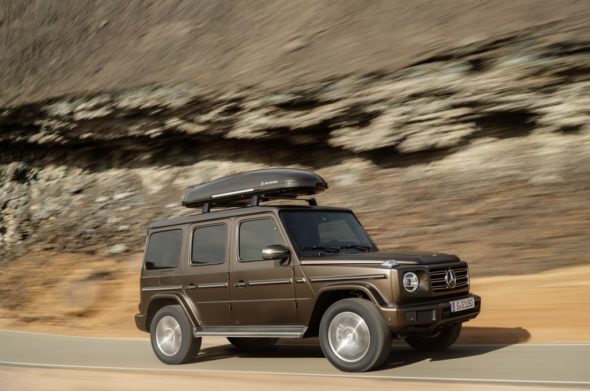
The optional Remote Online services allow drivers to connect to their vehicle from anywhere and at any time e.g. by smartphone, to access vehicle information and to remotely activate a variety of functions. The range of functions includes remote door locking/unlocking and programming of the auxiliary heating. This works both with the Mercedes me app (available for iOS and Android) and via the Mercedes me portal (www.mercedes.me).
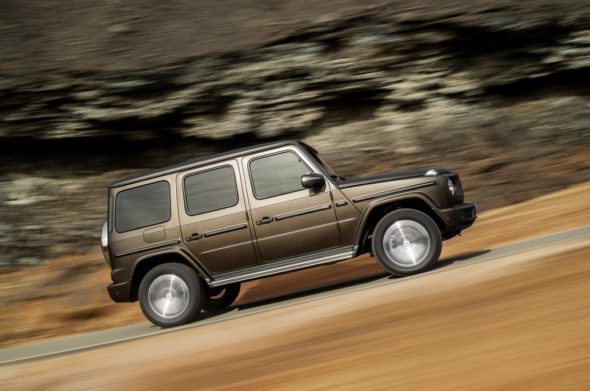
A further comfort highlight is the Concierge Service, which is now also available for the G-Class in conjunction with Mercedes me connect. Subscribed customers can take advantage of a number of individual services: from making a restaurant reservation to obtaining tips about tourist routes, information on cultural and sporting events and bookings through to sending navigation destinations directly to the vehicle.
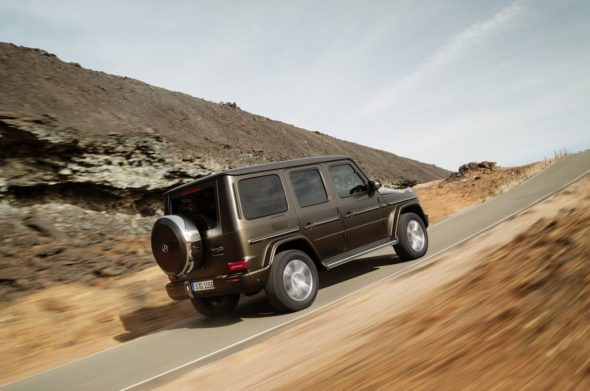
Access is straightforward: registered Mercedes me connect users can call up the Concierge Service in 20 countries across Europe, either via the iCall button in the vehicle or using the Mercedes me app. The personal concierge takes care of everything else.
Model range and equipment

More individual then ever
Almost 40 years after its market launch, the current G-Class is more youthful, agile and refined than ever before. This is also confirmed by the unit sales figures for the luxury off-roader. 2017 was the most successful sales year to date for the G-Class, with over 22,000 units sold worldwide. Now this classic is reinventing itself, and above all also excelling itself in its qualities as an off-roader.
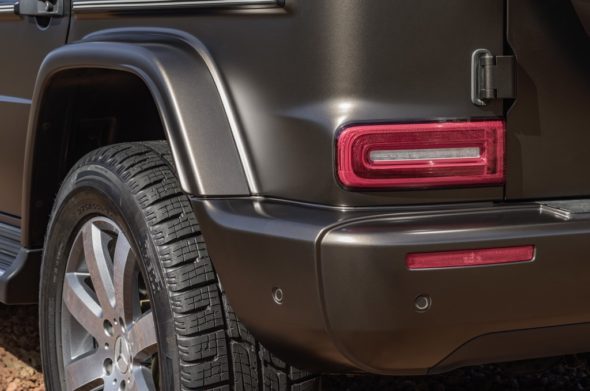
The new G-Class retains its unmistakable character where the exterior design is concerned. Its completely redeveloped interior impresses with more space, more stowage space and an ultra-modern infotainment system, for example. Intelligent assistance systems, the latest suspension technology and powerful, efficient engines further refine the multiple award-winning G-Class.
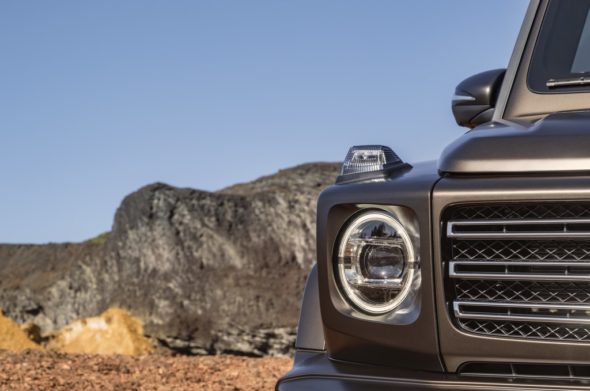
Already equipped to a high level ex factory, there are also numerous options with which the new G-Class can be configured to suit personal tastes. Eleven new paint finishes from cavansite blue metallic to designo citrine brown magno strike the right note. 24 paint colours are available, of which nine are metallic and 13 are designo colours. The designo olive metallic paint finish was last available for a Mercedes-Benz vehicle around twenty years ago, and has been specially included in the colour range for the new G-Class.
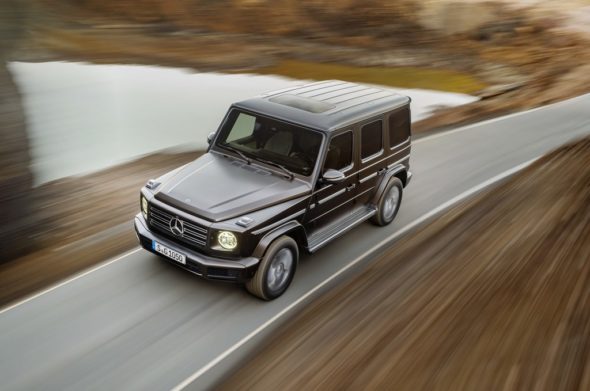
As standard the G-Class is fitted with 18-inch light-alloy wheels in a silver-painted 5-twin-spoke design (265/60 R 18 on 8J x 18 ET43). Numerous 18 to 20-inch wheels in new designs are also available as optional equipment. Furthermore, for particularly arduous applications, 18-inch all-terrain tyres are available.
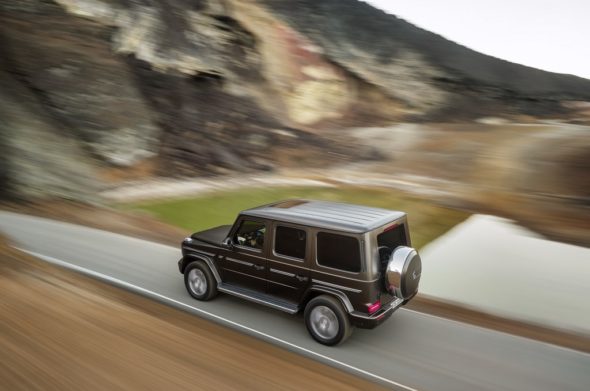
Extras for the G-Class: exclusive equipment packages
There are so many variants for the new G-Class that it is extremely rare for any two cars to be exactly alike. In addition to many optional extras, MercedesBenz also offers items from the very popular designo manufaktur ex factory.

Passengers are accommodated as standard on seats in Lugano leather in black, nut brown or macchiato beige. There is furthermore a choice of two top-class equipment packages: Exclusive Interior and Exclusive Interior Plus. The Exclusive Interior is available in a range of seven colours. Three of these are elegant combinations of nappa leather in black and one of the designo manufaktur colours platinum white, yacht blue or classic red.
The package also includes a black designo roof liner in DINAMICA microfibre, along with air vents in silvershadow. The Exclusive Interior Plus comprises additional elements in nappa leather, such as the door trim, sections of the centre console and the dashboard. A particular feature here is the seat design with dynamic diamond-pattern quilting. With this package, customers have a choice between the designo shades of black, espresso brown and classic red. For the first time it is also possible to order a light-coloured interior throughout in macchiato beige – encompassing everything from the flooring to the roof liner – in combination with espresso brown.
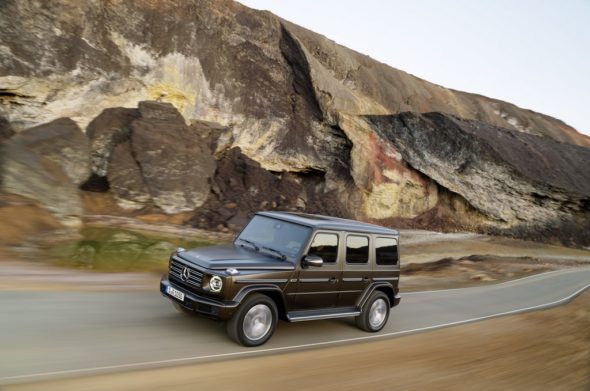
The sporty AMG Line can be combined with all three variants. In this case, black seats are combined with contrasting topstitching in red on the steering wheel, seats, dashboard, doors and centre console, along with red seat belts. This look goes well with the very sporty steering wheel with flattened lower section.

With the Night package, e.g. the exterior mirror housings, spare wheel cover and the surround of the Mercedes star are in obsidian black. Dark-tinted thermal insulation glass from the B-pillars to the rear and dimmed headlamps, indicators and tail lights round off the Night package.

As standard the ambience lighting offers a choice of eight colour tone mixes, and optionally Mercedes-Benz offers the LED-based system with 64 colours.

Intelligent load protection and transport solutions
The EASY-PACK load compartment cover shields luggage from sunshine and prying eyes. Smaller, unsecured items in the load compartment can be isolated with the EASY-PACK partition net. The newly developed roof rack is ideal for longer tours and recreational equipment such as a surfboard, snowboard or skis. The three cross-members can each be loaded with 50 kilograms, i.e. a total of up to 150 kilograms. The trailer coupling makes it possible to safely transport heavier loads of up to 3.5 tonnes in a trailer.
Body
The basis for extreme off-road use
Since its premiere in 1979, the G-Class has successfully relied on uncompromising functionality and outstanding off-road capabilities. Then and now, the basis for this is provided by a ladder-type frame with a mounted body. This design is considerably more robust and suitable for offroad operations than a unibody construction.
The ladder-type frame of higher-strength steel is able to resist torsional forces with greater stability. As the lowest point in the construction, it also ensures a low centre of gravity. Moreover, the robust frame protects the powertrain, fuel tank and exhaust system against ground contact, e.g. when driving over obstacles.

Working on the development of the new G-Class was extremely challenging for the team. “Further technical development of an icon such as the G-Class was both a challenge and an opportunity at the same time. Each part and every bolt came under close scrutiny,” explains Dr Gunnar Güthenke, Head of the OffRoad Product Group at Mercedes-Benz. “With the body, our main focus was on increasing the vehicle rigidity and the connections between the suspension and drivetrain with the ladder-type frame.”

Using a digital prototype, the developers simulated the service life of individual components and closed systems to find out in which places it would be possible to make use of lighter raw materials. The diet worked, as the G-Class has shed around 170 kg. The recipe for success: a new mix of materials comprising strong, high-strength, ultra-high-strength steels and aluminium, as well as improved production processes at the Magna Steyr plant in Austria. The rigid bodyshell is now made of a variety of steel grades, while the wings, bonnet and doors are made of aluminium.

To be able to retain the door hinges and handles typical of the G-Class, the developers modified these to suit the new aluminium design. The A and B-pillars are made of high-strength steel in view of their load-bearing function. However, less mass in no way translates into less stability – on the contrary, it was possible to increase the torsional rigidity of the frame, bodyshell and body mounts by around 55 percent, from 6537 to 10,162 Nm/deg. Alongside improvements to the natural driving dynamics and comfort, this also results in enhanced quality in terms of noise levels, among other things, with the positive effect of significantly less noise and vibrations being noticeable in the interior when driving.
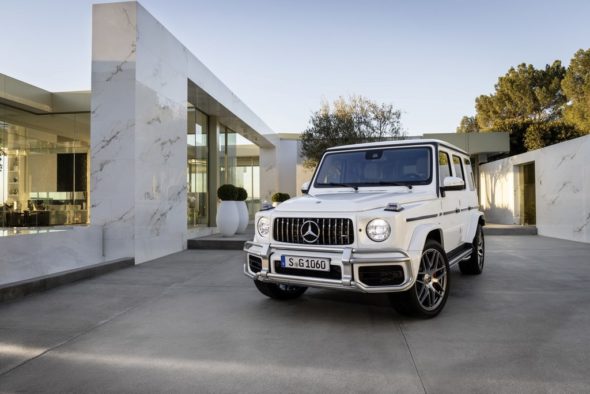
Focus on off-road performance
The roof of the G-Class is no longer spot-welded, but instead connected to the body structure by laser welding resulting in better surface quality and higher body strength. The flanged areas typical of the G-Class, e.g. between the side wall and roof, have been retained but improved for the new welding process.

Off-road capability was once again the main focus during further development of the doors. The side and rear doors have a protective foil cladding on the inside, so that no water can enter when fording watercourses. The surfaces of the frame, vehicle floor and body are specially treated to withstand even the most severe influences – whether water, snow, salt or sand.

For the first time, all the fixed windows of the G-Class are adhesive bonded to the body. This not only increases the torsional rigidity of the body, a particular advantage when driving on difficult terrain, but also makes the window frames more resistant to corrosion.
Custom shop
Collector’s items with the highest level of exclusivity
In 1972 the foundations were laid for the production of the almost 40-year success story that is the G-Class with a cooperation agreement between the then Daimler-Benz AG (today Daimler AG) and Steyr-Daimler-Puch (today Magna Steyr) in Graz, Austria.
This cooperation between Daimler-Benz and the Austrian all-wheel drive specialist Steyr-Daimler-Puch, previously best known for its extremely off-road capable “Haflinger” and “Pinzgauer” models, brought together the comprehensive off-road know-how that marks the driving characteristics of the G-Class to this day. The specialists in Stuttgart are responsible for design and construction, and for the majority of the testing work. A second team in Graz mainly concerns itself with the bodyshell design, development of the new transfer case and practical off-road testing.
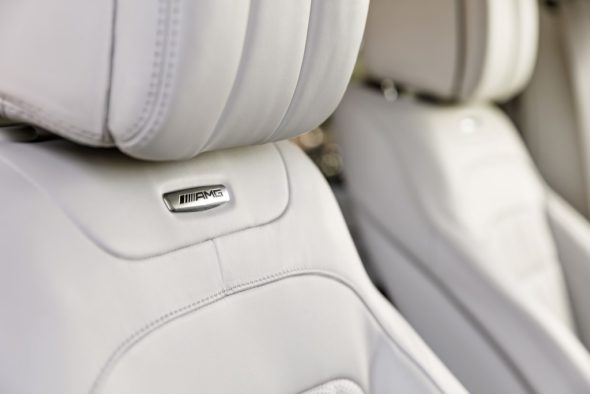
In 1977, “Geländefahrzeug GmbH” (GFG) was founded as an independent joint venture in which each partner held half the shares. This joint venture was responsible for production, and from 1992 the development work also came under the aegis of Graz.
In 1981 GFG was dissolved, and a restructuring of the respective functions between Daimler-Benz and Steyr-Daimler-Puch was carried out. Daimler-Benz was now exclusively responsible for further development work on the off-roader, with Steyr-Daimler-Puch focussing on production on a contracting basis.

In 2013 the company was logically renamed Mercedes-Benz G GmbH as a wholly-owned Mercedes-Benz subsidiary. This company, sales & marketing and product management of the civilian and non-civilian G-Class models are the responsibility of the Off-Road product division of Mercedes-Benz Cars based in Stuttgart-Möhringen. Strategic planning and market development are also based in Baden-Württemberg’s capital.

To this day, every single example of these legendary off-roaders in all body variants and engine variants right up to the AMG models has been assembled by Magna Steyr on just one production line. Around 2000 employees skilled in hand finishing techniques ensure that this precision tool takes its place on the roads and rough terrain. This takes the requisite amount of time.
Because only the greatest commitment and use of particularly fine materials can create an automobile that withstands both the inner-city jungle and the toughest terrain. Whether the exterior or interior, topstitching or model plate: almost every detail is lovingly produced with passion and to craftsman-like perfection.
Experienced master saddlers keep their eye on every detail during production of the seats, for example. High-grade types of leather are finished with an outstanding level of skill. Even the slightest flaw in the leather will not escape the professional eyes of the saddlers. The result is collector’s items with the highest level of exclusivity by the hands of masters.
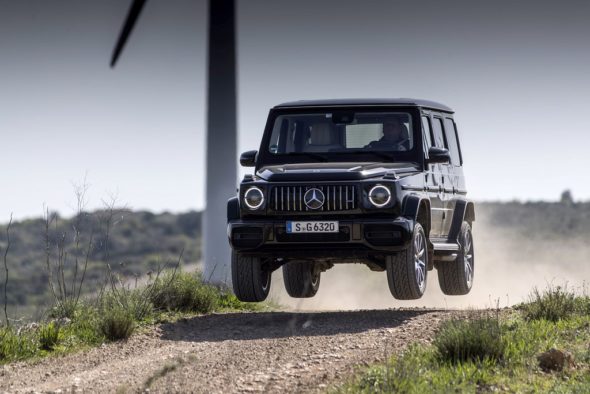
“The team which has contributed substantially to this success includes employees who have been part of the story of the G-Class for some 38 years or more. We are connected to Magna Steyr by decades of successful cooperation in the production of the G-Class,” says Dr. Gunnar Güthenke, Head of the Off-Road Product Unit at Mercedes-Benz.
This cooperation started in 1972 has evolved into a probably unique mix which combines all the advantages of a large automobile manufacturer with those of small, autonomous organisation and a custom shop. An example: for the first time the engineers at Mercedes-Benz are developing a fully digitised vehicle in the Graz location together with partners Magna Steyr and AMG.
It is only after many simulation cycles and positive results that test vehicles are built to accomplish the leap from the digital to the real world. In this way test drives and simulations are used to constantly improve the maturity of the G-Class so that it is fit for customers.
Suspension
Even better off-road, more dynamic than ever on the road
The Schöckl: this is where all G-Class generations have found their feet, and where the test drivers know every little obstacle. The Schöckl is the 1445metre high mountain near Graz, Austria which Mercedes-Benz uses as a test site for practical trials of the G-Class.
The 5.6 km route includes gradients of up to 60 percent and lateral inclinations of up to 40 percent. During the development stage, a “G” has to endure a good 2000 strenuous kilometres on this very demanding course. Plus there are a further 4000 kilometres of rough tracks. The new G-Class masters the route with noticeably more control and comfort.
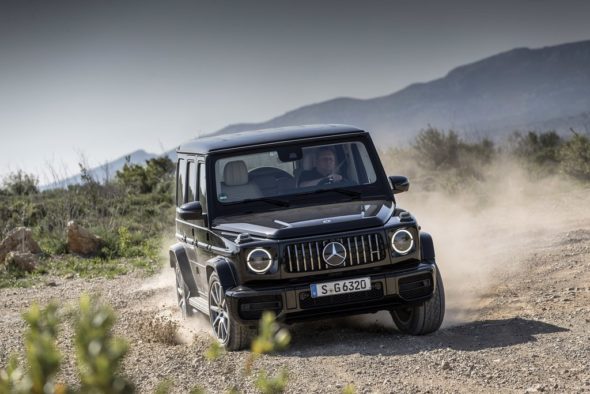
“There are many reasons for this extraordinary performance,” says Dr Gunnar Güthenke, Head of the Off-Road Product Unit at Mercedes-Benz. “First we have our new suspension technology with independent front suspension, the adaptively adjustable dampers and the electro-mechanical steering.”

The G-Class: far more than a cross-country vehicle
The new G-Class benefits from almost 40 years of experience and expertise in the off-road segment. The primary goal of development was to redefine the quality of the handling both on an off the road. This goal has been achieved: the new G-Class performs even better off-road, while on the road it is significantly more agile, dynamic and comfortable than its predecessor.
In 2014, joint development work on the suspension was started by Mercedes-Benz G GmbH and Mercedes-AMG GmbH. The result is an independent suspension with double-wishbone front axle in combination with a rigid rear axle. As part of their work, the engineers had the task of fighting for every millimetre, because off-road capability not least also means maximum ground clearance. The raising of the axles makes a decisive contribution in this respect, while requiring a strut tower brace in the engine compartment to achieve the ruggedness objectives.
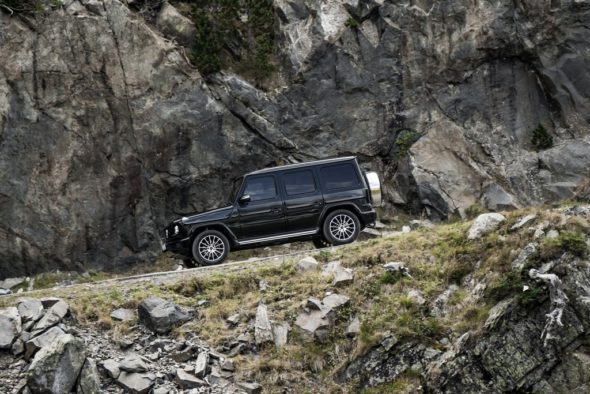
The components of the double-wishbone front suspension are directly mounted to the ladder-type frame without a subframe. The lower wishbone’s attachment points on the frame in Z-direction are positioned as high up as possible. This arrangement ensures good driveability beyond the asphalt. Specifically for the G-Class, the new front axle is designed in such a robust way that the off-road performance and off-road capabilities of its predecessor are maintained and partly even surpassed.

Equipped in this way and with a ground clearance of 270 mm to the front axle gear, the G-Class provides plenty of potential for maximum assertiveness and driving pleasure in off-road terrain. This is further enhanced by a maximum front spring travel of 85/100 millimetres and a ramp breakover angle of 25.7 degrees.
However, the specifications for the G-Class not only included off-road solidity and superiority, but also better driving dynamics and comfort on asphalted roads. Thanks to the new front axle design, the on-road performance of the
G-Class has therefore been enhanced at the same time. On the road, the “G” is as agile as it is comfortable and provides the driver with a better steering feel. The off-roader stays on track more solidly, and is agile and effortless when driving off-road.
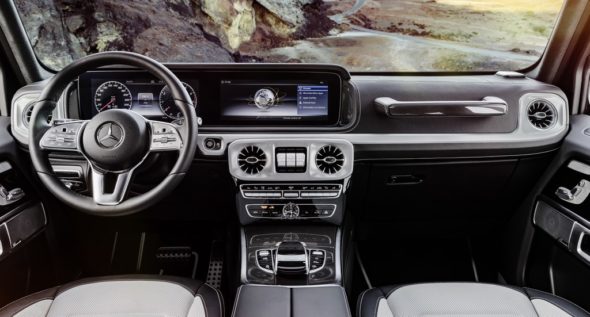
With the “G”, the fun really starts where others have to give up
The exceptional handling characteristics and driving safety on account of the driver’s high level of control need to be experienced at first hand. However, the following figures clearly show that every little detail to improve the off-road characteristics has been checked and optimised where possible.
As before, high ground clearance and long suspension travel form the basis for the further improved off-road characteristics of the G-Class. The figures speak for themselves:
Slope climbing ability of up to 100% on suitable surfaces
Ground clearance between axles, plus 6 mm, now 24.1 cm
Maximum fording depth now 70 cm when driving through water and mud, no less than an additional 10 cm
Stable at tilt angles of 35°, plus 7°
Angle of departure: 30°, angle of approach: 31°, plus 1°
Break-over angle: 26°, plus 1°
Thanks to the independent suspension, it was possible to improve the rigidity of the body front end. A strut tower brace, known as a suspension bridge, now connects the front strut towers, which increases the torsional rigidity of the ladder-type frame.
At the rear, in contrast to the predecessor, the new rigid axle is controlled by four trailing arms on each side and a Panhard rod. This makes normal driving on the road even more comfortable. In off-road terrain, the rear spring jounce of 82 mm and rebound of 142 mm plus the ground clearance of 241 mm to the rear axle gear help to ensure a safe ride even in extreme situations.
Bodyshell as robust as never before
How stable the G-Class is in practice already became apparent at an early development stage, after the first endurance runs. To this end the engineers needed to build driveable prototypes from the so-called structural verification vehicles that are produced to ensure passive safety. Worldwide endurance runs under all manner of climatic conditions commenced very early on. All in all, the vehicles covered 2.4 million kilometres during the development phase. Endurance runs on the Schöckl mountain were also a fixed part of the test programme. “The engineers reported back that the bodyshell is better than ever before,” says Dr Gunnar Güthenke.
DYNAMIC SELECT: make your choice
DYNAMIC SELECT is now available with several driving modes for the G-Class. This allows adjusting the vehicle characteristics in seconds at the touch of a button, as the system modifies the characteristics of the engine, transmission, suspension, steering and assistance systems at the driver’s behest. The driving modes “Comfort”, “Sport”, “Eco” and “Individual” can be set conveniently via the DYNAMIC SELECT rocker switch. “ECO” mode, for example, makes a particularly fuel-efficient and quiet driving style possible, as the exhaust flap is automatically closed. In “Sport” mode, on the other hand, the shift points of the automatic transmission, the throttle response of the engine and the parameters of the electric steering system and exhaust flap are changed. “Individual” allows drivers to configure their own preferred vehicle settings.
DYNAMIC SELECT provides a host of options in combination with the new suspension with optional Adaptive Damping System. The driver is then also able to modify the vehicle’s damping characteristics in Sport and Comfort modes using the DYNAMIC SELECT switch.
Put simply, the G-Class detects the particular condition of the road and sets the appropriate damping characteristics, so that the damping in off-road terrain is stiffer, for example. In contrast, in Sport mode the G-Class boasts a more agile response when driving on the road.
To adapt the damper response, the kinetic and potential energy currently stored in each wheel is ascertained and calculated in real time from the spring travel and its derivatives. Together with the body acceleration, the control unit computes individual signal values for the solenoid valves of each damper. The suspension therefore regulates each wheel individually, improving both on-road ride comfort and off-road performance.
In its standard specification the new G-Class is equipped with a conventional steel suspension and a frequency-selective passive damping system. Frequency-selective means that the damping characteristics vary according to the number of bumps crossed in a certain time.
The new “G-Mode” paves the way where there is none
One of the prerequisites for the improved off-road handling characteristics is the new “G-Mode”. The G-Class changes to “G-Mode” independently of the chosen driving mode as soon as one of the three differential locks has been activated or the LOW RANGE off-road reduction gear has been engaged. This off-road mode adapts the adjustable damping of the suspension and the steering as well as the accelerator characteristics, avoids unnecessary gear shifts and thus ensures optimum control and maximum off-road capability. A small “G” icon discreetly lights up in the instrument cluster. The “G” swallows rough ground so easily that the driver is able to enjoy inch-perfect manoeuvring even in the steepest terrain, and receive excellent steering feedback on the traction provided by the surface.
As direct as possible, as indirect as necessary
As standard the G-Class is now fitted with electromechanical rack-and-pinion steering, which now allows driving assistance systems such as Parking Assist to be implemented. In addition, the electromechanical steering uses less energy than a hydraulically assisted steering system. Depending on the driving mode, one of three sets of steering characteristic lines, namely Comfort, Sport and Off-road, comes into effect. This ensures a comfortable or sporty steering feel on the road, but also straightforward and precise feedback in unpaved and demanding terrain – always paired with sufficient steering power assistance. In a nutshell: as direct as possible, as indirect as necessary.
Internally ventilated brake discs are used at the front and rear axles, with a diameter of 354 and 345 millimetres and a thickness of 32 and 22 millimetres. This helps to reduce the weight of the G-Class, reducing fuel consumption while improving ride comfort. An electric parking brake is provided as standard.
Engine and transmission
Efficient power pack
In the new G 500 (fuel consumption, combined: 12.1-11.5 l/100 km; combined CO2 emissions: 276-263 g/km)1 a high-performance 4.0-litre V8 petrol engine ensures powerful propulsion. The new biturbo delivers an output of 310 kW (422 hp) and a maximum torque of 610 Nm at 2000 to 4750 rpm. Further power units are already planned.
Efficiency and effortless power delivery were the top priorities for the new
4.0-litre V8. One factor in this is the special NANOSLIDE® coating on the cylinder walls. This ensures less friction, which helps to improve efficiency and also reduces wear. The biturbo has a cylinder shutoff function to reduce fuel consumption even further. In the partial load range, the variable valve control system CAMTRONIC deactivates four cylinders at the same time. This reduces the gas cycle losses while improving the overall efficiency of the remaining four cylinders by shifting the operating point towards higher loads. Cylinder shutoff is active in the engine speed range from 800 to 3250 rpm in the Comfort and ECO driving modes. When torque increases, cylinders 2, 3, 5 and 8 are unnoticeably reactivated within milliseconds. The G 500 is also equipped with a petrol particulate filter.
Hot inside V
For even better engine responsiveness, the cylinder heads of the V8 biturbo are rotated by 180 degrees: the intake side is on the outside, the exhaust side on the inside, which makes the V8 biturbo particularly compact. Specialists refer to this concept as a “hot inside V”.
Key data of the G 500 at a glance:
G 500
Displacement 3982 cc
Bore x stroke 83.0 x 92.0 mm
Compression ratio 10.5:1
Output 310 kW (422 hp) at 5250-5500 rpm
Peak torque 610 Nm at 2000-4750 rpm
Fuel consumption, NEDC combined 1 12.1-11.5 l/100 km
CO2 emissions 1 276-263 g/km
Efficiency class E
Acceleration 0-100 km/h 5.9
Top speed 210 km/h
New automatic transmission on board
For the transfer of power, the 9GTRONIC automatic transmission with torque converter was specifically adapted to meet the needs of the off-road icon. The developers have managed to reduce the shift and response times of the 9-speed transmission by means of a dedicated software application. The wide transmission ratio not only makes driving quieter and more comfortable especially at low engine speeds, it simultaneously also contributes to reducing fuel consumption.
Further improved mechanical components and the hydraulic control unit ensure fast, gentle and comfortable gear shifts, and allow brisk intermediate sprints. In addition, three rpm sensors allow so-called nested gear changes, where several gears are skipped depending on the driving situation. The shift characteristics vary according to the selected drive program.
In ECO mode, the ECO start/stop function helps to ensure particularly economy-minded driving. The gliding function also helps to save fuel. When the driver’s foot leaves the accelerator pedal, the transmission’s clutch disengages. This reduces the engine speed to idling level, and the driving resistance is reduced by the compression and frictional forces of the engine on the overrun. The G-Class “glides”, using its own, current kinetic energy for a certain distance. It rolls for a measurably longer distance than when on the overrun. This results in further fuel savings. The clutch is re-engaged as soon as the driver operates the accelerator or brake pedal. As is usual with Mercedes-Benz automatic transmissions, the driver is able to change the gears manually. This is made possible by the DIRECT SELECT shift paddles at the steering wheel.
Transfer case with low-range ratio
The new transfer case is flange-mounted directly on to the 9G-TRONIC. It is configured so that 40 percent of the drive torque reaches the front axle and 60 percent reaches the rear axle. This configuration particularly benefits the handling characteristics on the road. At the same time the permanent all-wheel drive ensures maximum traction. However, the “G” would not be a “G” if it did not have even more in store. The low-range ratio considerably increases torque at the drive wheels, which e.g. makes very difficult terrain negotiable.
The low-range ratio can be engaged via the LOW RANGE switch in transmission mode N at speeds of up to 40 km/h. The gear ratio of the transfer case is then changed from 1.00 in HIGH RANGE to 2.93. It is possible to switch from LOW RANGE to HIGH RANGE at speeds of up to 70 km/h. The gear ratio of the transfer case is 2.93 and thus significantly shorter than in the predecessor model (2.1), which becomes noticeable particularly when pulling away on an extreme gradient.
The new, intelligent multiplate clutch behaves like an automatically controlled locking differential. It ensures that the G-Class remains manoeuvrable for longer. The advantage is that the driver has more scope before having to engage the differential locks manually. This means that the multiplate clutch controls the behaviour of the “G” when driving, e.g. in case of slip on or off the road. When the switch for the centre differential lock is operated, the multiplate clutch switches to a 100% fixed locking effect. The locks at the front and rear axle differentials are normal differential locks with a 100% locking effect. All the locks can be engaged individually while on the move, both in LOW RANGE and in HIGH RANGE, in the sequence centre, rear axle and finally front axle differential. The differential locks now respond to the switches even more rapidly, as they are purely electromechanically actuated and fully networked. An LED and the central driver’s display indicate which lock is currently active.
1 The stated figures were determined in accordance with the prescribed measuring method. These are the “NEDC CO2 figures” according to Art. 2 No. 1 Implementing Regulation (EU) 2017/1153. The fuel consumption figures were calculated based on these figures.
Safety
The safest G-Class of all time
The latest assistance and safety systems make the new-generation G-Class one of the safest vehicles in its segment. The luxury off-roader has ATTENTION ASSIST on board as standard, for example. This is able to give the driver a visual and audible warning when microsleep threatens, significantly improving safety on long journeys and at night. After the warning appears in the instrument cluster, COMAND Online automatically offers a service station search.
Also included as standard, Active Braking Assist is able to prevent impending collisions or mitigate their consequences, and assist the driver during emergency braking. If necessary it will brake autonomously if the driver takes no action to defuse a detected dangerous situation. In addition to slower-moving, stopping or stationary vehicles, the system can also detect pedestrians and cyclists crossing in the danger zone ahead of the vehicle.
Active safety at a high level
Active Lane Keeping Assist, which is included as standard, can use one-sided braking action to prevent the vehicle from unintentionally leaving its lane – for example when inadvertently crossing uninterrupted lane markings. The system uses a camera to recognise when the driver is crossing a lane marking. Steering wheel vibrations alert the driver to the situation. If the driver fails to react, the G-Class is braked on one side to return it to its lane.
Image recognition and information from the digital road map in the navigation system allow the permitted maximum speed and any restrictions on overtaking for the current route section to be computed and shown in the instrument cluster. Additional restrictions such as speed limits in wet conditions (warning when the windscreen wipers are switched on) or speed limits only for trucks are also taken into account. Traffic Sign Assist is also able to recognise no-entry signs and warn the driver to check the direction of travel.
Biomechanical ear protection
The preventive occupant protection system PRE-SAFE® intervenes when an accident threatens. This includes for example reversible seat belt tensioning or automatic closing of open side windows and the glass sliding roof to protect the occupants from penetrating objects. When PRE-SAFE® Sound recognises an impending collision, it prepares the hearing of the occupants for the expected crash noise to reduce harmful effects. By emitting a brief rushing sound from the sound system, it activates the stapedius reflex as a natural protective reflex in the inner ear. The stapedius muscle contracts, reducing contact between the ear drum and the inner ear. This better protects the inner ear against high sound pressure.
Less stress in convoy driving
The Driving Assistance package specially tailored to the G-Class is also optionally available. This further relieves driver workload in day-to-day driving with new and improved assistance systems, especially in convoy and stop-and-go traffic. The Driving Assistance package includes Active Distance Assist DISTRONIC and Blind Spot Assist. DISTRONIC automatically maintains a set distance from the vehicle ahead. This particularly relives the driver’s workload in convoy traffic.
Blind Spot Assist warns the driver when it detects vehicles in the blind spot. The warning is both audible and by warning symbols in the left or right exterior mirror.
Also available as optional equipment are the Parking package with reversing camera or the Parking package with 360° camera, which also include the parking assistant PARKTRONIC and Active Parking Assist. PARKTRONIC monitors the area to the front and rear of the vehicle, and warns against detected obstacles.
The new Active Parking Assist uses six ultrasonic sensors to recognise suitable parking spaces, and assists the driver with steering and braking when entering the space. Manoeuvring into and out of parallel and end-on parking spaces is made easier. In addition, Rear Cross Traffic Alert in conjunction with the optional Driving Assistance package can warn of crossing traffic when reversing out of parking spaces.
The view to the rear, and therefore safety when reversing, if further improved in the new G-Class because the camera is mounted below the spare wheel and allows a wider angle of vision. As the camera is positioned below the fording line of the G-Class, it is protected in a way similar to an underwater camera and covered by a flap. The protective mechanism opens as soon as the driver engages reverse gear, and the very special “diving equipment” of the G-Class is ready for action.
In conjunction with the optional 360° camera of the Parking package, an all-round bird’s-eye view is possible with the reversing camera and three further cameras. This view shows an area of approx. three metres around the G-Class. This means that obstacles located below the window line or in front of the vehicle, e.g. a kerb or a hill crest, do not remain hidden. The information is clearly shown in full HD in the display of the multimedia system. Dynamic guide lines show the road and the width of the G-Class. The driver can choose between a detailed, side or full-screen view. A front view with an off-road view is also possible. All this guarantees an outstanding view during a variety of manoeuvres or in the dark.
If the vehicle is equipped with a trailer coupling, it is possible to activate trailer mode. In this case the driver is assisted when manoeuvring, and able to hitch up a trailer without outside help.
The off-road display specially developed for the G-Class appears in the multimedia system, and shows a diagram of the G-Class in the off-road environment. In addition the components important for off-road driving are shown:
lockable transfer case with low-range gear flange-mounted to the automatic transmission
shafts from the transfer case to each axle gear
lockable rear axle differential incl. rigid axle/side shafts to the rear wheels
lockable front axle differential with side shafts to the front wheels
In addition, the off-road screen shows data such as altitude, gradient, incline, steering angle, low-range gear and activated differential locks. The direction of travel is also visible in a segment of a circular compass in front of the virtual
G-Class. A diagram of the all-wheel drive system at the lower right edge of the screen shows the front and rear wheels, the front and rear side shafts, the front and rear axle differentials, the front and rear longitudinal shafts and the transfer case.
Passive safety: protecting the occupants
The passive safety of the new G-Class is based on a new body design with a particularly rigid passenger cell, the ladder-type frame and specifically deformable crumple zones. In a frontal crash, the ladder-type frame uses a special support to direct longitudinal forces into the floor structure. The extra-rigid passenger cell gives the occupants sufficient protective space. It also reduces the deceleration forces acting on the occupants in an accident.
Several restraint systems protect the occupants. These are activated as needed:
front airbags for the driver and front passenger
two kneebags
thorax-pelvis sidebags in the front
windowbags for the front and rear
Optional: sidebags in the rear
3-point seat belts with belt tensioner, anchor fitting tensioner and belt force limiter in the front and pyrotechnical belt tensioner with belt force limiter for the outer rear seats
Pedestrian protection is very important
Active safety systems such as Braking Assist with its emergency braking function for crossing pedestrians and cyclists help to prevent or considerably mitigate the consequences of accidents, particularly those involving more vulnerable road users such as pedestrians and cyclists. In the interests of passive safety, the deformation spaces between the bonnet and the components below it have been adjusted. The developers went to considerable effort in order to retain the iconic design feature of mounted direction indicators: plastic frames were bonded into apertures stamped out of the upper surfaces of the front wings, and the indicators were attached to these. In the event of an impact with a pedestrian, predetermined fracture points in the plastic frames give way and the indicators disappear into the space provided in the front wings.
More light
The G-Class is equipped with LED High Performance headlamps as standard. Their colour temperature is closer to that of daylight than xenon headlamps, for example. This is more restful on the eyes and therefore provides relief to the driver at night.
All lighting functions including the daytime running lamps are integrated into single headlamp units. Thanks to the LEDs, the road ahead is illuminated better than by conventional halogen headlamps. The 20.2 watt LED low-beam headlamps also have very low energy consumption thanks to the new technology – around 58 percent less than a 35 watt xenon headlamp and around 40 percent less than a 50 watt halogen headlamp. Standard equipment in the new G-Class also includes headlamp washer nozzles. These are particularly useful for removing mud splashes after a cross-country tour. Like the reversing camera, the tail lights and headlamps are waterproof.
High-resolution MULTIBEAM LED headlamps are available as an alternative to the LED High Performance headlamps. These each use 84 individually controlled high-performance LED modules to illuminate the road surface automatically with an extremely bright and precisely directed beam of light, without dazzling other detected road users. That is because this individual control allows the light distribution of the left and right headlamps to be adapted separately, quickly and dynamically to suit the changing situation on the road. This improves safety for all road users. With the enhanced fog light function, the MULTIBEAM LED technology also allows the headlamp on the driver’s side to illuminate that side more actively, while masking any rise in the light beam. As a result, the outer half of the road surface is more brightly illuminated and back-glare from the light reflected from the fog is reduced.
New safety-enhancing functions
Adaptive Highbeam Assist Plus also benefits from the performance of MULTIBEAM LED technology: thanks to a larger number of pixels, the dark areas in the light distribution are more precise and dynamic than ever before in partial main-beam mode, and the main beam can be used for longer than before. Once switched on, the system always makes the best possible headlamp range available.
History
The evolution of a legend
1979
The first G-Models are presented to the press. Production start-up of the 240 GD, 300 GD, 230 G and 280 GE.
1980
During his visit to Germany in November 1980, Pope John Paul II is for the first time chauffeured in a “Popemobile” based on the 230 G.
1981
An air conditioning system, side-facing bench seats for the load surface and a hardtop for the convertible become optionally available for the 280 GE and 300 GD. There is a choice of 22 colours.
1983
In the Paris-Dakar Rally, Jacky Ickx and Claude Brasseur are first across the finishing line in a 280 GE.
1985
The “G” is significantly upgraded by a model facelift. Standard equipment now also includes differential locks, central locking and a rev counter.
1987
Further facelift with power windows, automatic aerial, twin-roller load compartment cover and larger tank.
1989
Launch of the 463 series with superior equipment and four engine variants: 250 GD, 300 GD, 230 GE and 300 GE.
There is a choice of three body versions: Convertible, short-wheelbase Station Wagon, long-wheelbase Station Wagon.
1993
The 500 GE appears as the first V8 model of the off-roader. The 5-litre light-alloy engine of the limited special model develops 177 kW/240 hp. “G” as a model prefix: from September the G-Models are officially known as the G-Class. The model designations are G 230, G 300, G 350 TURBODIESEL etc.
1994
Second facelift for the 463 series, with internally ventilated front disc brakes and a driver airbag.
1996
Presentation of the new G-Class Cabriolet with an electro-hydraulic soft top and the G 300 TURBODIESEL.
1998
The G 500 with a V8 engine (218 kW/296 hp) is added to the regular model range.
1999
With the G 55 AMG, an AMG variant is for the first time included in the sales portfolio of the G-Class.
2001
The G-Class is given a considerably upgraded interior as part of a model facelift. The extended standard equipment now including new dynamic control systems is presented at the International Motor Show (IAA) in September. These include ESP®, Braking Assist BAS and the new electronic traction system ETS.
2004
World premiere of the new G 55 AMG with a supercharged V8 engine. The most powerful G-Class to date has an output of 350 kW/476 hp.
2007
Further updating: the G-Class is given a new instrument cluster with four analogue dial instruments.
2008
Introduction of the new 5.5-litre V8 engine with 285 kW/388 hp. Modified radiator grille with three louvres.
2012
Completely redesigned dashboard and centre console, with the modern infotainment system COMAND Online on board as standard. The performance subsidiary in Affalterbach enters the lists with the G 65 AMG. On board: a
6.0-litre twelve-cylinder engine with a carbon-fibre/aluminium engine cover. With torque of 1000 newton metres, the G 65 AMG is the world’s most powerful series production off-roader – its top speed has to be electronically limited to 230 km/h.
2013
The G 63 AMG 6×6 demonstrates superior off-road capabilities.
2015
The designo manufaktur range becomes available for the G-Class for the first time. This captures customers’ imagination with individual appointments, traditional craftsmanship and the highest quality.
The individualisation programme offers exclusive, unique colour and material compositions both inside and out. In addition, the new G 500 4×42 with portal axles enters series production.
2016
The G 350 d Professional with a decidedly functional exterior and a special, optionally available Off-Road package is added to the G-Class model range.
2017
The 300,000th Mercedes-Benz G-Class leaves the production line at the Magna Steyr plant in Graz, Austria.
The Mercedes-Maybach G 650 Landaulet – a limited edition of 99 units – is launched with numerous luxurious items of special equipment.
The progenitor of all Mercedes-Benz SUVs
It has set standards since 1979. It has won the Paris-Dakar Rally, even served as a means of transport for the Pope and regularly wins reader votes as an automotive styling icon. The G-Class is a top model amongst luxury off-road vehicles. It is not only the passenger car model series with the longest production run in the history of Mercedes-Benz by far, but also the forefather of all SUVs to bear the three-pointed star – this is why all Mercedes off-road models feature the upper-case G in their name.
From the robust ladder-type frame to the comfortable seats: what also confirms the outstanding quality of the G-Class is the fact that 80 percent of the more than 300,000 examples produced are still in action – either on the roads or off them.
Graz writes history
The endless history of the G-Class began in 1972 with a cooperation agreement between Daimler-Benz AG and Steyr-Daimler-Puch in Graz, Austria. In 1975 the decision was also made to commence series production of the G-models. At the same time it was agreed to construct a new plant in Graz, where the vehicles have been manufactured ever since, mainly built by hand.
The concept on which the partners agreed was radically different from that of other all-wheel drive vehicles at the time. Going against the trend at that time, the plan was to develop neither a Spartan “purely off-roader” nor an all-wheel drive passenger car for the road. Instead, after careful consideration, the product planners, designers and engineers came up with a versatile off-roader with then unparalleled attributes: they firstly required reliability, robustness and superior off-road capabilities, so as to prevail in tough industrial, municipal and military operations. Secondly, the result was to be a fully-fledged, comfortable and above all safe road vehicle that would also find buyers as an exclusive recreational vehicle.
Based on a very strong ladder-type frame
The best solution proved to be separation of the frame from the body, as the future G-Class was to be offered in various body versions from its inception. For this reason, a ladder-type frame has always formed the backbone of the Mercedes-Benz off-roader.
A joint company was founded for sales and construction of the vehicle, Geländefahrzeuggesellschaft mbH in which Daimler-Benz and Steyr-Daimler-Puch each had a 50 percent share. The consortium decided on the simple but distinctive name “G”, standing for “Geländewagen” (off-road vehicle). At that time nobody could have guessed that this was an almost visionary decision in view of the later change in the nomenclature of Mercedes-Benz passenger cars classes, using just a single letter.
Production of today’s G-Class started on 1 February 1979 in Graz. The complete drive system with engine, transmission, axles and steering came from Daimler-Benz, as did large pressed parts. Punched and small pressed parts, as well as the transfer case, were produced by Steyr-Daimler-Puch.
At the time of its market launch, in the spring of 1979, it was available with a choice of four engine variants covering a performance spectrum of 53 kW/72 hp to 115 kW/156 hp. Customers had the option of a Cabriolet with a short wheelbase and a panel van or Station Wagon each with short or long wheelbase.
In the autumn of 1989, the G-model family gained new members. Alongside the revised original model with the internal model series abbreviation 460, which would from then on remain in service as a “workhorse”, the new models of the 463 series extended the range. This started an evolutionary process that not only constantly adapted the off-roader in line with technical advances. It was an evolution that also brought a steadily expanding fan base and emphasised its character as an exclusive vehicle for any occasion.
Popular for special duties and with the Pope
In numerous special-purpose versions, the off-roader also showed its versatility in operation with the police, fire service and rescue services.
The vehicles built for Pope John Paul II, usually known as “Popemobiles”, also gained world fame. The Mercedes-Benz 230 G painted in mother-of-pearl with a special glass body accompanied Pope John Paul II on numerous journeys around the world. Mercedes-Benz first made the vehicle available to the Pope for his visit to Germany in late autumn 1980 – initially as a loan. In 1982 another 230 GE followed that was almost identical in terms of the exterior.
The “G” is given its name
In spring 1993, the long history of the G-Class reached one of many high points: with the launch of the eight-cylinder 500 GE (177 kW/240 hp) in a small special series of 500 units. In September 1993 the model designations of the off-road vehicles were changed over to the new nomenclature system adopted for Mercedes-Benz passenger car models; the “G” now preceded a three-figure number, and the suffixes “E” (denoting fuel injection) and “D” (for diesel) were dispensed with. At the same time the G-Model was officially named the G-Class.
The first AMG model of the G-Class entered the market in the anniversary year 1999: the G 55 AMG. The G 55 AMG Kompressor followed in the 25th anniversary year 2004. Its eight-cylinder power unit (350 kW/476 hp, 700 Nm of torque) gave the robust off-roader an unprecedented level of performance and demonstrated the tremendous potential of the G-Class. Two years later the engineers at AMG uprated the “Power G” even further, raising output to
368 kW/500 hp.
In 2006, the off-road vehicle was given a new, ultra-modern diesel engine. The G 320 CDI, which is regarded as one of the best “Gs” of all time by many enthusiasts, has an output of 165 kW/224 hp and features a diesel particulate filter as standard. Its light-alloy V6 engine further increased driving pleasure with its smooth torque curve – both on and off the road.
In addition, on its 30th birthday in 2009, the G-Class was given new equipment features, which increased interior comfort and exclusivity in particular. The ergonomically optimised front seats offered more support, while new designs and climatised seats made the veteran beast even more luxurious.
Always on course for growth
New AMG engines, a markedly expanded range of appointments, an even higher-quality interior, careful exterior modifications and safety features such as DISTRONIC Plus as well as the parking aid PARKTRONIC ensured further enhancement of the off-roader in 2012.
A year later, Mercedes-Benz expanded the product portfolio with the G 63 AMG 6×6: a three-axle off-road vehicle that combined the “best of three worlds”, featuring as it did all the developments of the new G-Class generation, the robustness of heavy off-highway vehicles and the superior engine technology of Mercedes-AMG. The G 500 4×4² of 2015 not only added a luxurious interior to the equation, but also a ground clearance of 45 centimetres and impressive on-road performance.
Those wishing to give their G-Class a particularly special character can make use of the designo manufaktur programme available since 2015. Not only striking paint finishes, but also diverse equipment variants and fine leather upholstery with stylish topstitching are now available.
Sales of the G-Class have increased continually since 2009. Thanks to strong growth rates, the progenitor of the SUVs achieved a new unit sales record in 2017, with over 22,000 units sold within one year.
Thanks to the Mercedes-Maybach G 650 Landaulet, the iconic G-Class reinvented itself once more in 2017. With its superlative V12 engine, portal axles, electric fabric top and exclusive appointments in the rear compartment, this very special all-terrain vehicle, limited to 99 units, meets the expectations of customers who demand the very highest standards of their vehicle. Arguably the most exclusive form of open-air driving pleasure.
The summer of 2017 saw the 300,000th G-Class roll off the assembly line in Graz – a Mercedes-Benz G 500 in designo Mauritius blue metallic with black leather seats and contrasting white topstitching. Equipped with a range of off-road features including all-terrain tyres mounted on black 16-inch rims and a sturdy roof rack, the anniversary vehicle embarked on new adventures over the summer. G-Class fans around the world determined the vehicle specification by voting for their favourite equipment and appointments on the official G-Class Facebook page. The future road trips of the 300,000th G-Class can be followed on social networks.
The new Mercedes-AMG G 63
New appearance of the high-performance G-Class
Affalterbach. With the new Mercedes-AMG G 63 (combined fuel consumption: 13.1 l/100 km; combined CO2 emissions: 299 g/km)1, the Mercedes-AMG G-Class has undergone the greatest change in its history – while remaining true to its well-proven virtues. The G 63 underpins its unique position among performance off-road vehicles with the powerful drive system, the newly developed AMG RIDE CONTROL suspension, the AMG-specific transmission modes and the new interior with optimal widescreen cockpit. The basis for the hallmark AMG Driving Performance both on and off metalled roads is provided by the 430 kW (585 hp) 4.0-litre V8 biturbo engine, the rear-biased all-wheel drive (40:60) with three differential locks, the extremely fast-shifting 9-speed automatic transmission, the double wishbone independent front suspension and the adaptive adjustable damping. The reinterpretation of the unmistakable design creates strong highlights with the AMG-specific radiator grille, flared wheel arches, striking side pipes on the exhaust system and the up to 22-inch wheels.
“The new AMG G 63 brings driving performance to the segment of unadulterated off-road vehicles in unexpected form. It was important for us to tie in with the original character on account of the cult status the G 63 enjoys with our customers and fans. The vehicle has nevertheless reached a completely new dimension in terms of technology with the 4.0 litre V8 biturbo engine as well as in combination with the off-road characteristics, the agility and the vehicle dynamics achieved”, explains Tobias Moers, CEO of Mercedes AMG GmbH. “This applies to the entire G Class model series. Mercedes-AMG is responsible for their suspension and chassis development as well as V8 competence.”
Proven to be powerful: the AMG 4.0-litre V8 biturbo engine
The AMG 4.0-litre V8 biturbo engine now also replaces the previous 5.5-litre V8 biturbo engine in the G 63. It generates 430 kW (585 hp) in this model, and delivers a maximum torque of 850 Nm. This is available across a wide rev range between 2.500 and 3.500 rpm, and provides a sense of effortless superiority. It absolves a sprint from zero to 100 km/h in 4.5 seconds. This dynamic performance is maintained up to the limited maximum speed of 220 km/h, or 240 km/h with the AMG Driver‘s package.
The two turbochargers are not positioned on the outside of the cylinder banks, but inside the cylinder “V”. Advantages: a compact engine design, spontaneous response of the turbochargers and low exhaust emissions thanks to optimal airflow to the near-engine catalysts. The eight-cylinder delivers its power with muscular torque in all engine speed ranges, combined with maximum efficiency for low fuel consumption and emission figures.
Two twin scroll turbochargers are used for optimal response. The housing is divided into two parallel flow channels. Combined with two separate exhaust ducts in the exhaust manifold, this makes it possible to control the exhaust gases on the turbine wheel separately. The exhaust gas from the first and fourth cylinders of the cylinder bank is fed into one duct, that from the second and third cylinders to the other duct. The aim is to prevent the individual cylinders from having mutually adverse effects on the gas cycle. This reduces the exhaust gas back pressure and improves gas exchange. The results are increased output by virtue of improved cylinder charging with fresh mixture, more torque at low revs and very fast response times.
Other engine features include modified pistons, optimised intercooling and extensive software upgrades. Spray-guided direct petrol injection with piezo injectors, the all-aluminium crankcase, the four-valve per cylinder design with camshaft adjustment, air-water intercooling, alternator management, the ECO start/stop function and the gliding mode have all been retained.
AMG Cylinder Management cylinder deactivation system
For more efficiency, Mercedes-AMG has equipped the V8 engine in the G 63 with the AMG Cylinder Management cylinder deactivation system. In the partial-load range, cylinders two, three, five and eight are deactivated, which significantly lowers the fuel consumption. The combined fuel consumption is 13.1 l/100 km, and the combined CO2 emissions 299 g/km.
When the driver has selected the “Comfort” transmission driving mode, the cylinder deactivation system is available in the wide engine speed range from 1000 to 3250 rpm. The AMG main menu on the instrument cluster informs the driver whether the cylinder deactivation system is in use and whether the engine is presently operating in the partial or full-load range. The transition from four to eight-cylinder operation is fast and imperceptible, so that the passengers do not experience any loss of comfort whatsoever.
AMG SPEEDSHIFT TCT 9G transmission with shorter shift times
The AMG SPEEDSHIFT TCT 9G transmission is used in the G 63. This has a model-specific software application to achieve very short shift times. The multiple downshift function allows more spontaneous bursts of speed, while the double-declutching function in “Sport” and “Sport Plus” transmission modes makes for an even more emotional driving experience. Defined engine manipulation makes for even faster gear changes.
The wide ratio spread allows a choice of a very sporty or a very comfortable and efficient driving experience. In all transmission modes the G 63 moves off in first gear so as to ensure a dynamic sprint from a standstill whenever required. The DIRECT SELECT lever has been repositioned as a steering column stalk.
“Manual” mode can be selected using a separate switch. The gear changes are based on the selected transmission mode, and the driver can now change gear using the paddles on the steering wheel. Moreover, the transmission stays in the selected gear and does not automatically shift up when the engine speed reaches the limit.
Enhanced agility and traction: AMG Performance 4MATIC all-wheel drive
The standard-specification AMG Performance 4MATIC all-wheel drive features rear-biased torque distribution with a front/rear split of 40 to 60 percent. This configuration ensures greater agility on the road and improved traction during acceleration. In the preceding model the distribution was still a neutral 50:50.
The off-road reduction gear has been developed further for operations on difficult terrain. It helps to ensure that the G 63 is able to master even more demanding off-road stretches. The reduction ratio of the transfer case is now 2.93, i.e. considerably higher than in the preceding model (2.1). This assists moving off on extreme uphill gradients in particular, as the torque at the drive wheels is significantly increased.
The off-road reduction gear can be engaged via the LOW RANGE switch at speeds of up to 40 km/h. The gear ratio of the transfer case is then changed from 1.00 in HIGH RANGE to 2.93. It is possible to switch from LOW RANGE to HIGH RANGE at speeds of up to 70 km/h.
The new, intelligent multiplate clutch behaves like an automatically controlled locking differential. It ensures that the new G 63 remains manoeuvrable for longer when off-road. The advantage is that the driver has more scope before having to engage the differential locks manually.
When the driver operates the switch for the centre differential lock, the multiplate clutch switches to a 100% locking effect. The locks at the front and rear axle differentials are differential locks with a dog clutch and a 100% locking effect. All the locks can be engaged individually while on the move, both in LOW RANGE and in HIGH RANGE, firstly centre, then rear axle and finally front axle differential.
The differential locks now respond to the switches even more rapidly, as they are electromechanically actuated and fully networked. An LED and the central driver’s display indicate which lock is currently active.
With adaptive adjustable damping: AMG RIDE CONTROL suspension
The new G 63 performs even better when off-road, and on the road it is more dynamic and comfortable than its predecessor. The agile driving impression is substantially due to the suspension system, which has been completely redesigned by Mercedes-AMG and features coil springs all-round. For the first time the front axle has an independent, double wishbone suspension; a rigid axle with a five-link suspension is used at the rear.
The components of the double-wishbone front suspension are directly mounted to the ladder-type frame without a subframe. The attachment points of the lower wishbone are positioned as far up as possible. This arrangement ensures good driveability both on and off the road. A strut tower brace, known as a suspension bridge, now connects the front strut towers, which increases the torsional rigidity of the ladder-type frame.
At the rear, the new axle is guided with four longitudinal control arms on each side and a Panhard rod. This makes normal driving on the road even more comfortable. When off-road, the rear spring compression of 82 mm and rebound of 142 mm plus the ground clearance of 241 mm to the rear axle gear help to ensure a safe ride even in extreme situations. To reduce body roll, the G 63 has additional transverse stabilisers at the front and rear axles.
The AMG RIDE CONTROL suspension with adaptive adjustable damping is standard equipment. This fully automatic, electronically controlled system adjusts the damping at each wheel to the current requirements. This improves driving safety and ride comfort. The damping is adjusted individually for each wheel, and depends on the driving style, the road surface and the selected suspension setting. The ideal operating point can be selected at all times on the basis of extensive information relating to acceleration or vehicle speed, for example.
Via a switch on the centre console, the driver can choose between three different sets of damping characteristics, namely “Comfort”, “Sport” and “Sport+”, and thus individually influence the driving experience from very comfortable to taut and sporty.
Direct and with clear feedback: the AMG speed-sensitive steering
The electromechanical speed-sensitive steering installed in the G 63 for the first time has a variable ratio to ensure precise and authentic feedback. The steering servo assistance is reduced at high speeds, and continuously increases at low speeds. This means that comparatively little steering force is required at low speeds, and that the best possible control over the vehicle is maintained at high speeds. Steering power assistance is available in a choice of two modes – “Comfort” or “Sport”. The relevant characteristics are automatically activated depending on the selected DYNAMIC SELECT driving mode, or can be personalised in “Individual” mode. In “Sport” the driver receives more direct feedback about the driving status.
Characteristics at the touch of a finger: AMG DYNAMIC SELECT
For the first time in the history of the Mercedes-AMG G-Class, the driving characteristics can be individualised at the touch of a finger with five on-road and three off-road driving modes.
With the five DYNAMIC SELECT on-road modes “Slippery”, “Comfort”, “Sport”, “Sport+” and “Individual”, the characteristics range from efficient and comfortable to very sporty. Key parameters such as the response of the engine, transmission, suspension and steering are modified in the process. Independently of the DYNAMIC SELECT drive programs, the driver has the option of pressing the “M” button to switch directly to manual mode, in which gearshifts are executed exclusively using the shift paddles on the steering wheel. If required, the stages of the adaptive adjustable suspension can be selected as well.
Three off-road modes – “Sand”, “Trail” and “Rock” – are available when driving off the beaten track. These are accessed using the switch in the centre console for activation of the central differential lock, and can then be selected with the DYNAMIC SELECT rocker switch. “Trail” allows maximum performance on soft, muddy or slippery surfaces. “Sand” modifies the parameters for sporty dynamics and the best possible grip and steerability on sandy stretches or desert sand dunes. “Rock” is the mode for extremely demanding, rocky terrain with severe axle articulation and frequent lifting of one or more wheels.
All the driving modes, both On Road and Off Road, are visualised in the instrument cluster and in the central media display. Deselection of all the locks returns the setting to the on-road driving modes.
Bodyshell: made for the toughest jobs
The basis for the enormous off-road capabilities of the G 63 is provided by a torsionally rigid ladder-type frame of high-strength steel and a mounted body of composite construction. This design is considerably more robust and suitable for off-road operations than a unibody construction. As the lowest point of this construction, the frame ensures a low centre of gravity and protects the major assemblies, fuel tank and exhaust system during ground contact, e.g. when driving over obstacles.
Another development aim was to reduce the weight of the body. Using a digital prototype, the developers simulated the operating life of individual components and assemblies to determine where lighter materials could be used without compromising durability, operating life and quality.
The result is a new material mix: the bodyshell consists of various grades of steel. The wings, bonnet and doors are made of aluminium. To be able to retain the door hinges and handles typical of the G-Class, the developers modified these to suit the new aluminium design. The A and B-pillars are made of high-strength steel in view of their load-bearing function.
Thanks to this intelligent design, it was possible to increase the torsional rigidity of the frame, body shell and body mounts by around 55 percent, from 6537 to 10,162 Nm/deg. This provides the ideal basis for maximum handling precision. Comfort has also benefited: vibrations and noise in the interior have been considerably reduced.
The roof is no longer spot-welded, but instead connected to the body structure by laser welding resulting in better surface quality and higher body strength. The flange width was retained, but optimised for the new welding method. For the first time, all the fixed windows are adhesive bonded to the body. This not only increases the torsional rigidity of the body, but also makes the window frames more resistant to corrosion.
Off-road capability was the main focus during further development of the doors. The side and rear doors have a protective foil cladding on the inside, so that no water can enter when fording watercourses. The surfaces of the frame, vehicle floor and body are specially treated to withstand even the most severe influences – whether water, snow, salt or sand.
Sporty and distinctive: the exterior design
Unmistakable design features give the new AMG G 63 its unique appearance: the boxy silhouette, the proud bonnet, external door hinges, round headlamps, mounted direction indicators, robust door handles, muscular protective strips with inserts in high-gloss black with a silver AMG emblem, the exposed spare wheel on the rear door with a stainless steel cover and three-dimensional Mercedes star.
The front section of the G 63 is characterised by the AMG-specific radiator grille and the AMG bumper with large side air inlets and trim in matt iridium silver. The headlamps, indicators and tail lights are in LED High Performance technology as standard. This lighting consumes less energy and has a particularly long service life.
MULTIBEAM LED headlamps are optionally available. These each use 84 individually controlled high-performance LED modules to illuminate the road surface automatically with an extremely bright and precisely directed beam of light, without dazzling other road users. That is because this individual control allows the light distribution of the left and right headlamps to be adapted separately, quickly and dynamically to suit the changing situation on the road. This improves safety for all road users.
With the enhanced fog light function, the MULTIBEAM LED technology also allows the headlamp on the driver’s side to illuminate that side more actively, while masking any rise in the light beam. As a result, the outer half of the road surface is more brightly illuminated and back-glare from the light reflected from the fog is reduced.
New light functions for enhanced safety
Adaptive Highbeam Assist Plus also benefits from the performance of MULTIBEAM LED technology: thanks to a larger number of pixels, the dark areas in the light distribution are more precise and dynamic than ever before in partial main-beam mode, and the main beam can be used for longer than before. Once switched on, the system always makes the best possible headlamp range available.
Mercedes-AMG G 63 with further distinctive features
Other characteristics of the G 63 include the flared front and rear wheel arches, which create space for the larger, wider wheels. Running boards as standard, distinctive trim elements on the front and rear bumpers and metallic paintwork as standard round off the exclusive exterior. Other distinguishing features include the “V8 BITURBO” lettering on the front wings and the Mercedes-AMG G 63 model badge on the rear door. Red brake callipers, perforated brake discs and 22-inch wheels available for the first time round off the exterior design.
The G 63 looks particularly striking with the optional AMG Night package. In this case the headlamps, tail lights, indicator lenses, rear window and rear side windows are dark-tinted. The obsidian black paint finish on the exterior mirror housings, the spare wheel ring and the trim in the front and rear bumpers, together with the black-painted underride guard, emphasises the confident appearance which is rounded off by matt-black 21 or 22-inch wheels.
Sporty look with model-specific details: the interior design
The new G 63 has been given a completely newly designed, modern interior that echoes specific exterior features. The shape of the round headlamps is reflected in the side air vents, and that of the indicators in the tweeters on the dashboard. Hallmarks of the G 63 also include the grab handle in front of the front passenger and the chrome-highlighted switches for the three differential locks.
The completely redesigned dashboard has analogue tubes as dial instruments as standard. Optionally the fully digital Widescreen Cockpit with virtual instruments directly in the driver’s field of vision and a central display above the centre console can be ordered. The two 12.3-inch displays visually blend into a single unit beneath a shared glass cover. The driver is able to choose from three different views – “Classic”, “Sporty” and “Progressive” – and access the required information individually.
The new dimensional concept in the interior benefits all the occupants. The increase in length (+101 millimetres), width (+121 millimetres) and height (+40 millimetres) provides the basis for a significantly more airy and spacious impression than in the previous model. The most important interior dimensions at a glance:
Description Difference
Legroom in the front +38 mm
Legroom in the rear +150 mm
Shoulder room in front +38 mm
Shoulder room in rear +27 mm
Elbow room in front +68 mm
Elbow room in rear mm +56 mm
The rear seats can be folded down in a ratio of 40, 60 or 100 percent. The seats in the G-Class are equipped as standard with numerous convenience functions and are ergonomically designed, thus providing enhanced seating comfort and lateral support. Features include the Memory function for the driver’s seat, seat heating front and rear, as well as luxury head restraints in the front.
This ride comfort can optionally be boosted still further with the Active Multicontour Seat package. In addition to the special multicontour seats, this encompasses such features as various massage functions, climate-controlled seats, and fast seat heating. This variant also offers electrically adjustable lumbar supports for the driver and front passenger. The side sections of the seat cushions and backrests of the active multicontour seats include integrated air chambers that fill or empty continuously depending on the driving dynamics, thus providing better support for the seating positions of driver and front passenger and, for example, offering more lateral support during cornering.
New AMG Performance steering wheel as standard
Extremely sporty design, a grippy shape with a heavily contoured rim and intuitive operation are the key attributes of the new AMG Performance steering wheel in nappa leather, which is standard equipment. It has a flattened lower section and is perforated in the grip area. The steering wheel shift paddles are galvanised.
Using the integrated touch control buttons, the functions of the instrument cluster (left) and multimedia system (right) can be intuitively controlled by horizontal and vertical swiping movements of a finger. As in the S-Class, the settings for Active Distance Assist DISTRONIC and cruise control are made in the left control panels. The control panels on the right are used to activate the voice control and telephone, and to regulate the sound volume, music selection and other functions of the multimedia system.
Typical AMG V8 exhaust note
The dual-flow exhaust system features side pipes below the rear doors. The twin tailpipes in high-gloss chrome emit the typical AMG V8 sound. The standard exhaust flap can be adjusted in two stages using the switch in the centre console or depending on the selected driving mode, to make the exhaust note more sporty or discreet.
Exclusive “Edition 1” special model at market launch
On market launch the new Mercedes-AMG G 63 will also be available as an exclusive “Edition 1” special model: the combination of equipment details turns the special model into the flagship of the range. The available paint finishes are magnetite black, obsidian black, iridium silver, mojave silver, selenite grey, designo graphite metallic, designo platinum black. designo mystic white bright, designo platinum magno and designo night black magno. As a discreet contrast the sports stripes along the vehicle sides are in matt graphite grey. The exterior mirror housings have a decorative red stripe. The AMG Night package with features in high-gloss black reinforces the muscular impression. The matt black 22-inch forged wheels in a cross-spoke design have red-painted rim flanges.
The red highlights continue in the interior: They can be found on numerous interior features, for example as red contrasting topstitching on the dashboard support, centre console, door panels and rear seats. The front sport seats in black/red pepper nappa leather also show this striking colour. The sport seats feature a dynamic diamond pattern with red contrasting topstitching as standard. The carbon-fibre trim has highlights in red pepper, and the Performance steering wheel in DINAMICA microfibre with a flattened lower section is embellished with red contrasting topstitching and a red 12 o’clock marking.
The market launch of the new Mercedes-AMG G 63 starts in June 2018. The basic price in Germany is 148,434.65 euros (including 19% VAT).
1 The stated figures were determined in accordance with the prescribed measuring method. These are the “NEDC CO2 figures” according to Art. 2 No. 1 Implementing Regulation (EU) 2017/1153. The fuel consumption figures were calculated based on these figures.
Mercedes-Benz G 500
Engine
Number of cylinders/arrangement V8
Displacement cc 3982
Bore x stroke mm 83.0 x 92.0
Rated output kW/hp 310/422 at 5250-5500 rpm
Rated torque Nm 610 at 2250-4750 rpm
Compression ratio 10.5:1
Mixture formation High-pressure injection
Power transmission
All-wheel drive permanent
All-wheel torque distribution, front/rear (%/%) 40/60
Transmission 9G-TRONIC
Ratio
Overall ratios Final drive ratio
1st gear
2nd gear
3rd gear
4th gear
5th gear
6th gear
7th gear
8th gear
9th gear
Reverse 3.45
5.35
3.24
2.25
1.64
1.21
1.00
0.86
0.72
0.60
4.80
Suspension
Front axle Double-wishbone suspension, torsion-bar stabiliser
Rear axle Rigid axle
Braking system Vented front disc brakes, vented rear disc brakes, electric parking brake, ABS, Braking Assist, ESP®
Steering Electromechanical rack-and-pinion power steering
Wheels 7.5 J x 18 (fr.), 7.5 x 18 (rear)
Tyres 265/60 R 18 (fr.), 265/60 R 18 (rear)
Dimensions and weights
Wheelbase mm 2890
Track, front/rear mm 1638/1638
Length mm 4.817
Width mm 1931
Height mm 1969
Turning circle m 13.60
Boot capacity, max.* l 1941*
Kerb weight acc. to EC kg 2429
Payload kg 721
Perm. GVW kg 3150
Tank capacity/of which reserve l 75/10.0
Performance and fuel consumption
Acceleration 0-100 km/h s 5.9
Top speed km/h 210
NEDC fuel consumption, combined 1 l/100 km 12.1-11.5
Combined CO2 emissions 1 g/km 276-263
*acc. to VDA measuring method
1 The stated figures were determined in accordance with the prescribed measuring method. These are the “NEDC CO2 figures” according to Art. 2 No. 1 Implementing Regulation (EU) 2017/1153. The fuel consumption figures were calculated based on these figures.
Mercedes-AMG G 63
Engine
Number of cyl./arrangement 8/V, 4 valves per cylinder
Displacement cc 3982
Bore x stroke mm 83.0 x 92.0
Rated output kW/hp 430 kW (585 hp) at 6000 rpm
Rated torque Nm 850 Nm at 2500-3500 rpm
Compression ratio 10.5: 1
Mixture formation Microprocessor-controlled direct petrol injection, charging with two exhaust gas turbochargers and 1.2 bar max. boost pressure
Power transmission
Drive system AMG Performance 4MATIC permanent all-wheel drive with rear-biased torque distribution 40:60 (f:r)
Transmission AMG SPEEDSHIFT TCT 9G transmission
Gear ratios Final drive ratio
1st gear
2nd gear
3rd gear
4th gear
5 gear
6th gear
7th gear
8th gear
9th gear
Reverse gear n/a
5.35
3.24
2.25
1.64
1.21
1.00
0.87
0.72
0.60
-n/a
Suspension
Front axle AMG chassis with 4-link front suspension, steel springs, gas struts
Rear axle AMG chassis with 5-link rigid axle, steel springs, gas struts
Braking system Dual-circuit hydraulic braking system with vacuum booster, stepped master
brake cylinder; 400 mm internally vented and perforated disc brakes at the front
with six-piston aluminium fixed calliper; 370 mm internally vented and perforated
disc brakes at the rear with single-piston aluminium floating brake calliper;
electric parking brake, ABS, Brake Assist, ESP®
Steering Electromechanical speed-sensitive power steering system with toothed rack,
variable ratio and variable steering power assistance
Wheels front: 9.5 J x 20; rear: 9.5 J x 20
Tyres front: 275/50 R 20; rear: 275/50 R 20
Dimensions and weights
Wheelbase (ready to drive) mm 2890
Track, front/rear mm 1654/1654
Overall length mm 4873
Overall width mm 1984
Overall height mm 1966
Turning circle m
Boot capacity* l 454
Kerb weight acc. to DIN** kg 2485
Kerb weight acc. to EC*** kg 2560
Payload (based on kerb weight acc. to EC) kg 640
Perm. GVW kg 3200
Tank capacity/of which reserve l 100/12
Performance and fuel consumption
Acceleration 0-100 km/h s 4.5
Top speed km/h 220 km/h****
Fuel consumption combined1 l/100 km 13,1
Combined CO2 emissions1 g/km 299
Efficiency class E
*According to German Association of the Automotive Industry measuring method; **Kerb weight according to DIN without driver; ***Kerb weight according to EC including driver (75 kg); **** Electronically limited, optional increase in max. speed to 240 km/h (only in conjunction with the AMG Driver’s Package)
1 The stated figures were determined in accordance with the prescribed measuring method. These are the “NEDC CO2 figures” according to Art. 2 No. 1 Implementing Regulation (EU) 2017/1153. The fuel consumption figures were calculated based on these figures.


